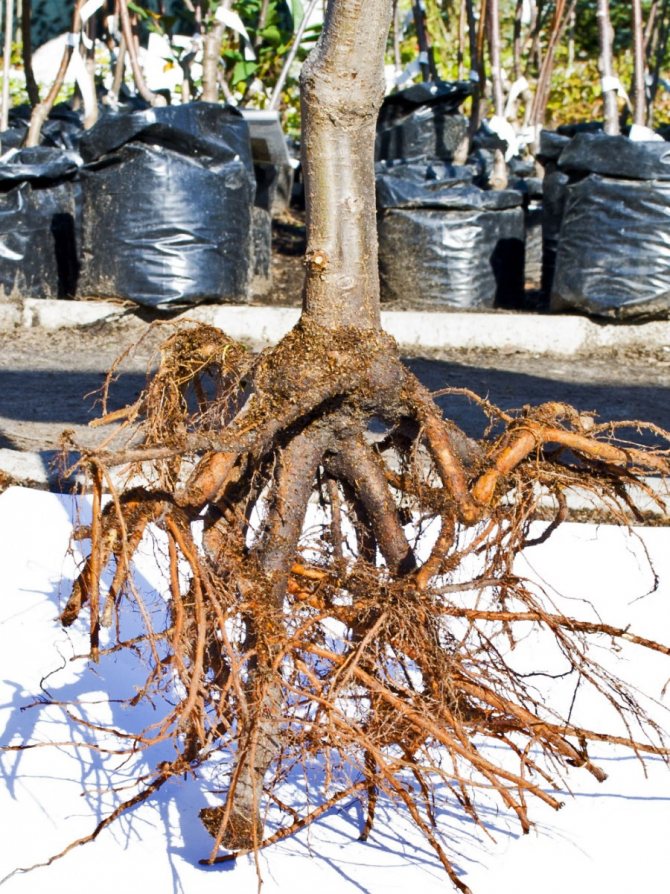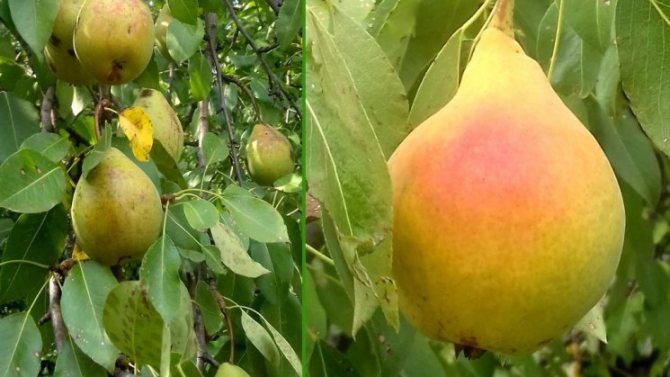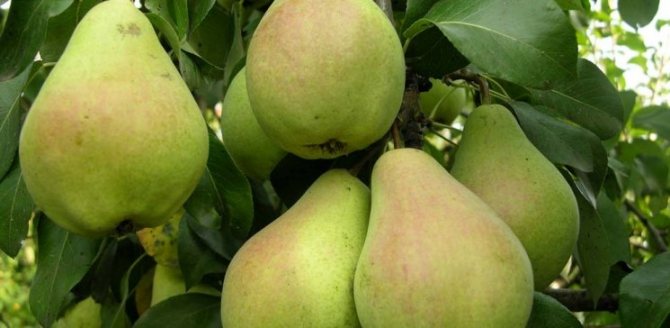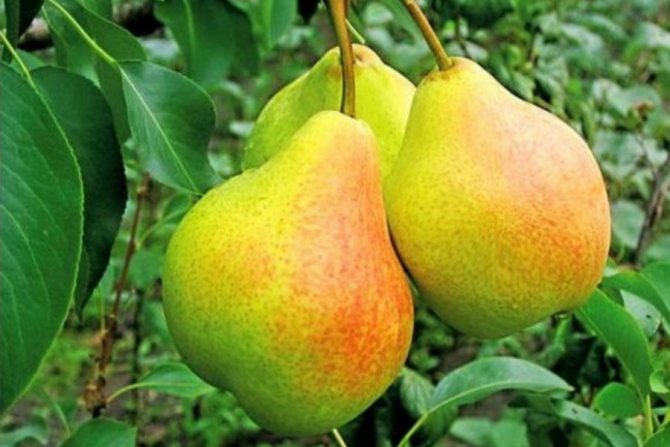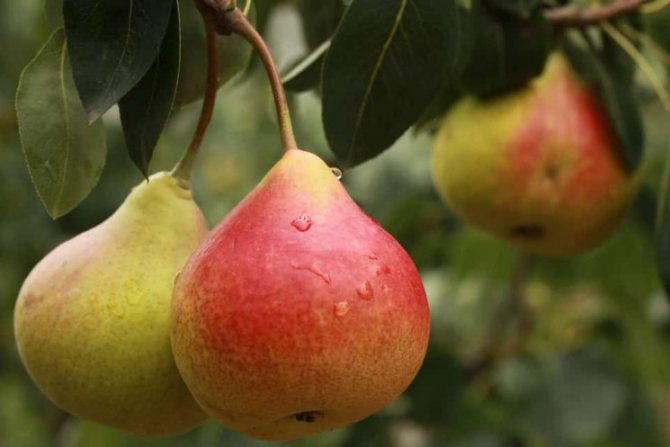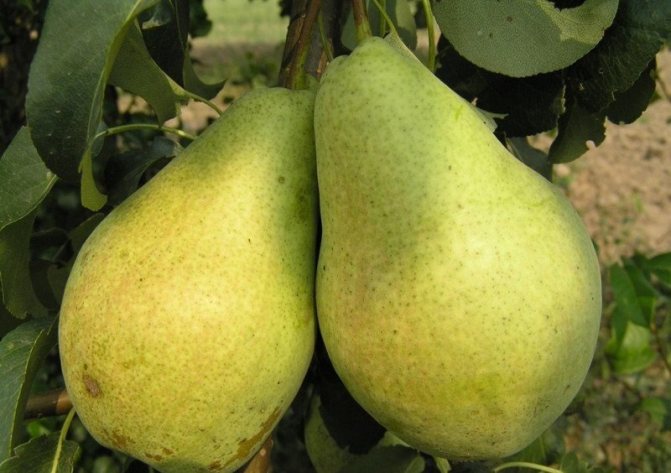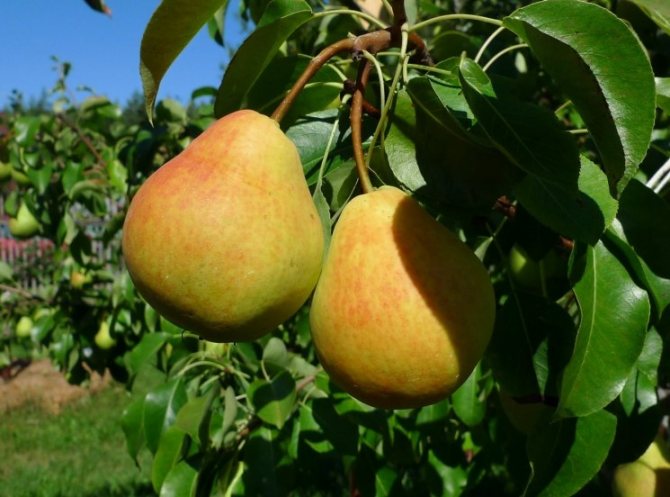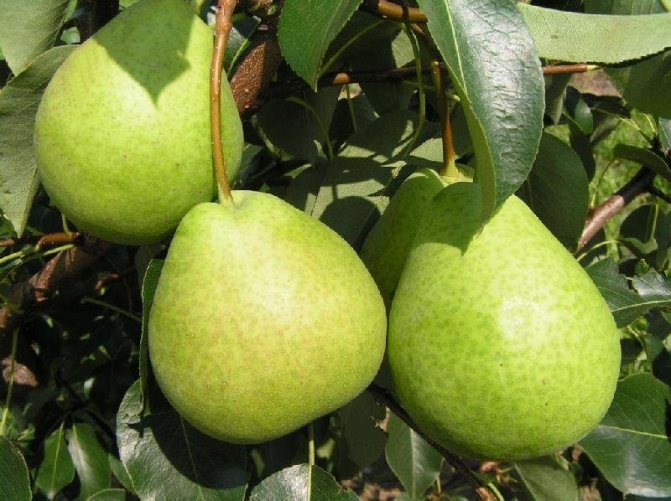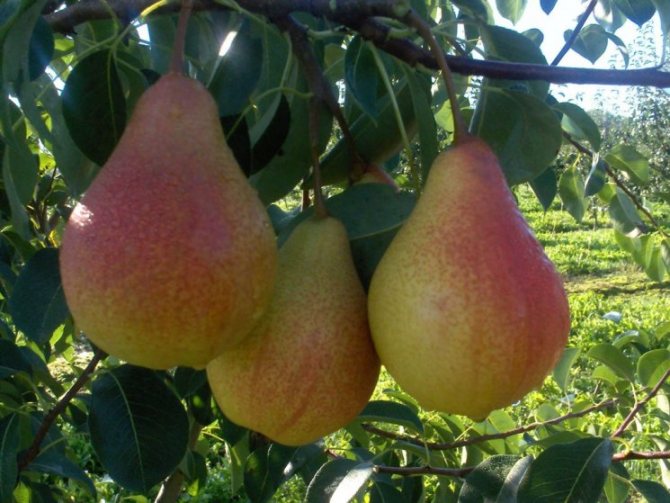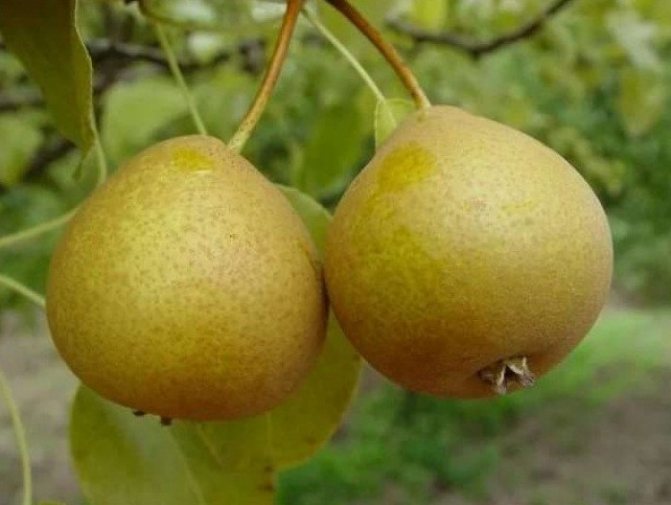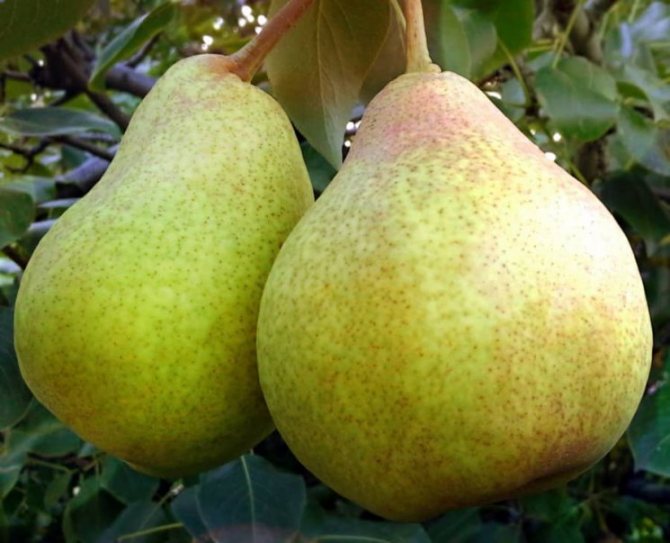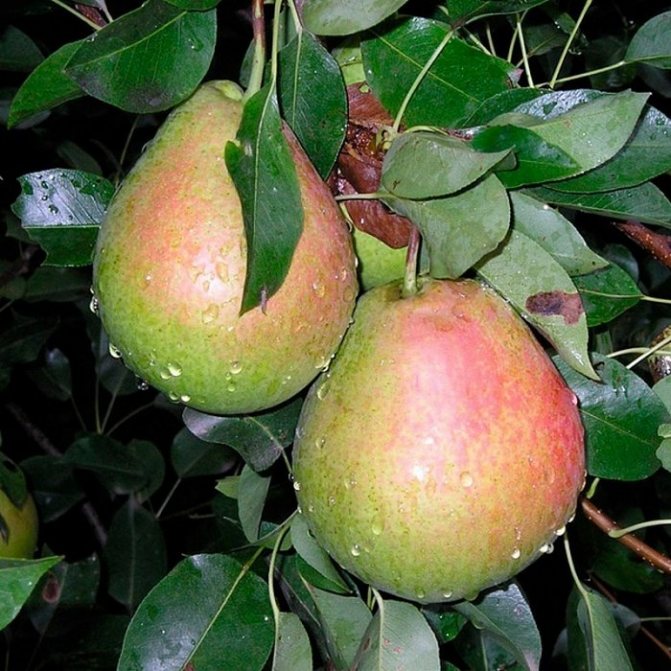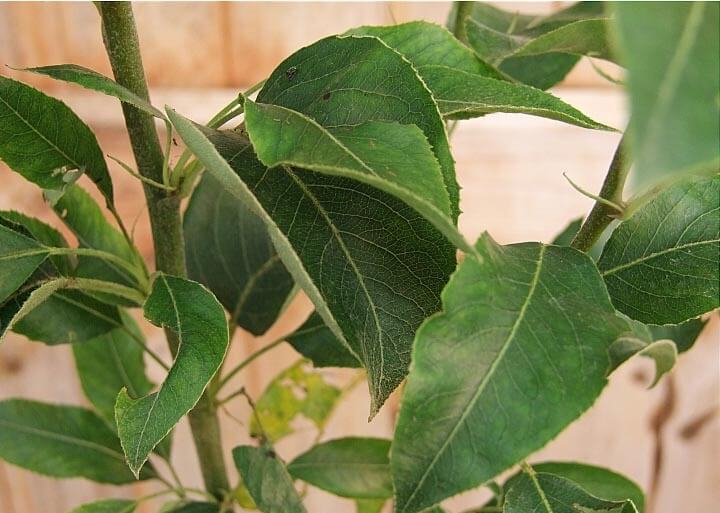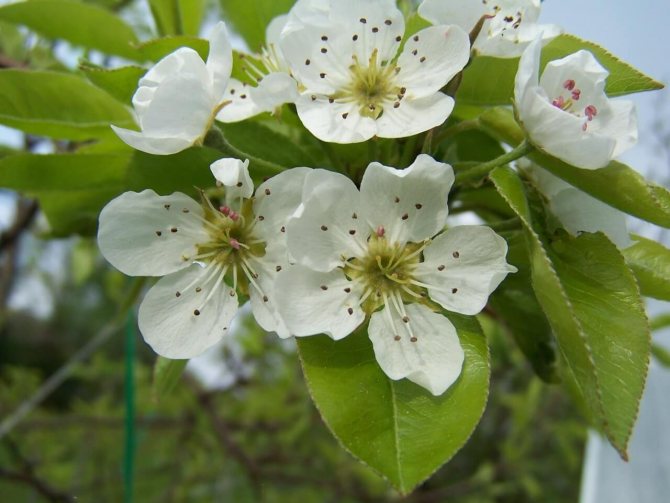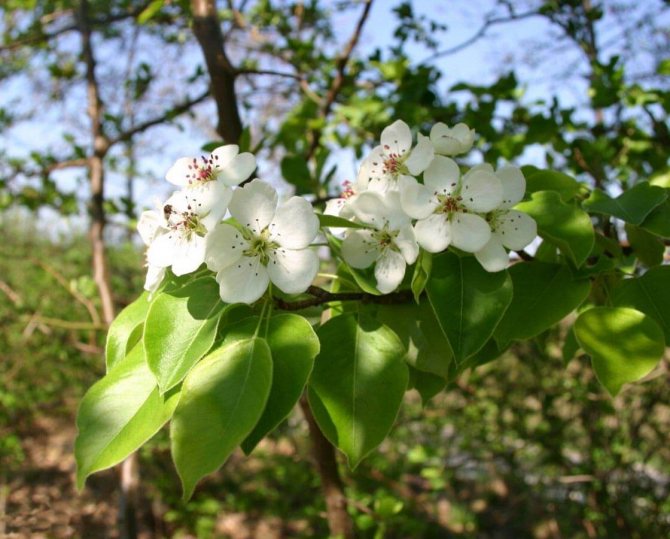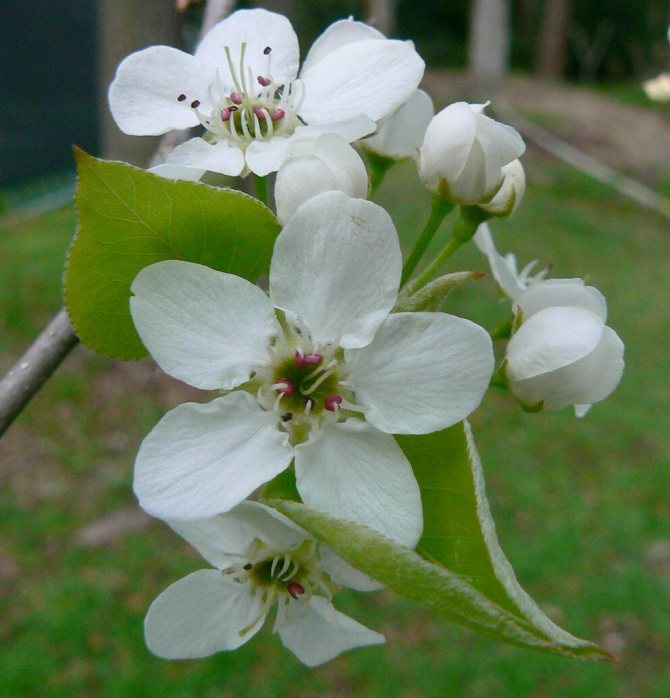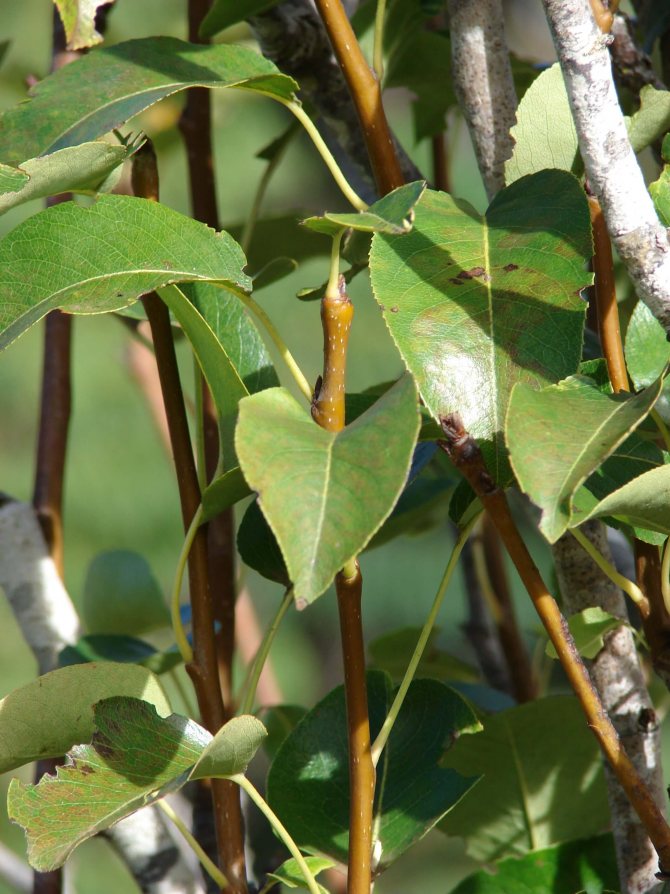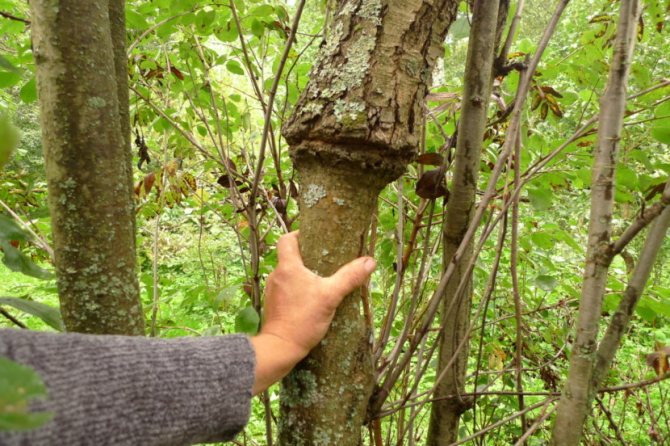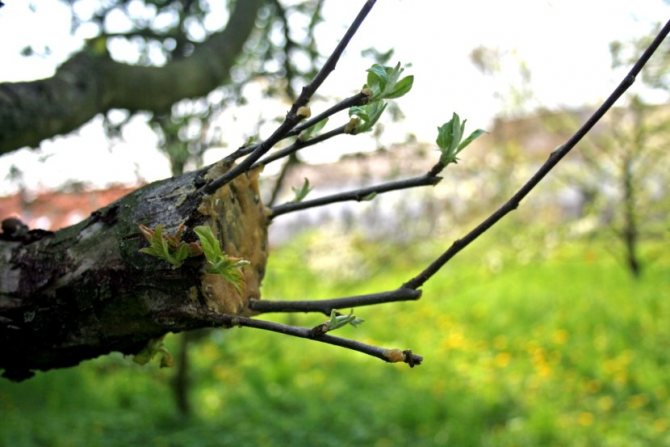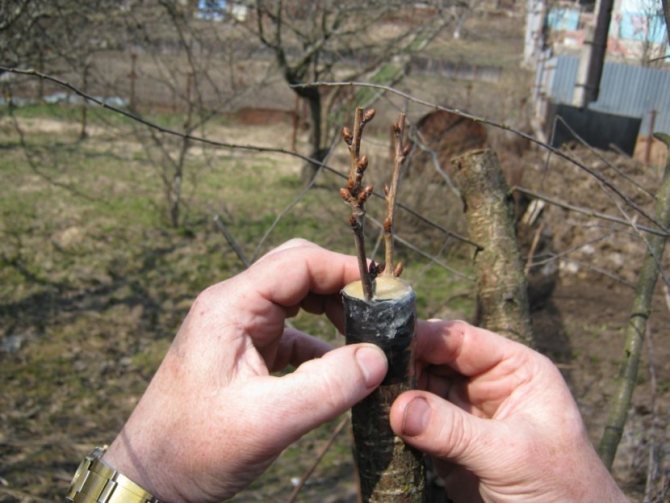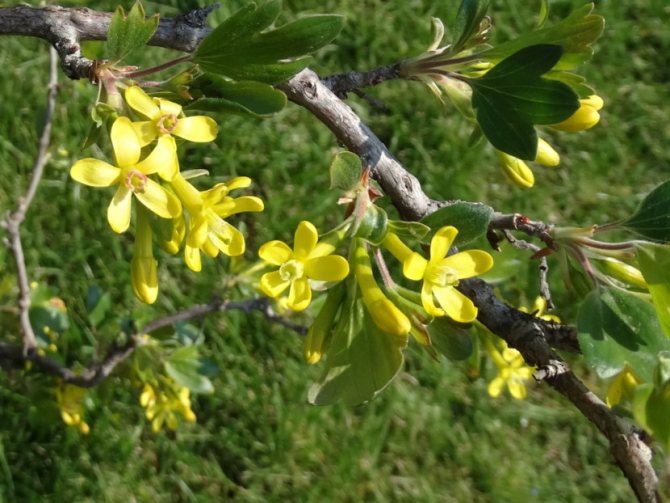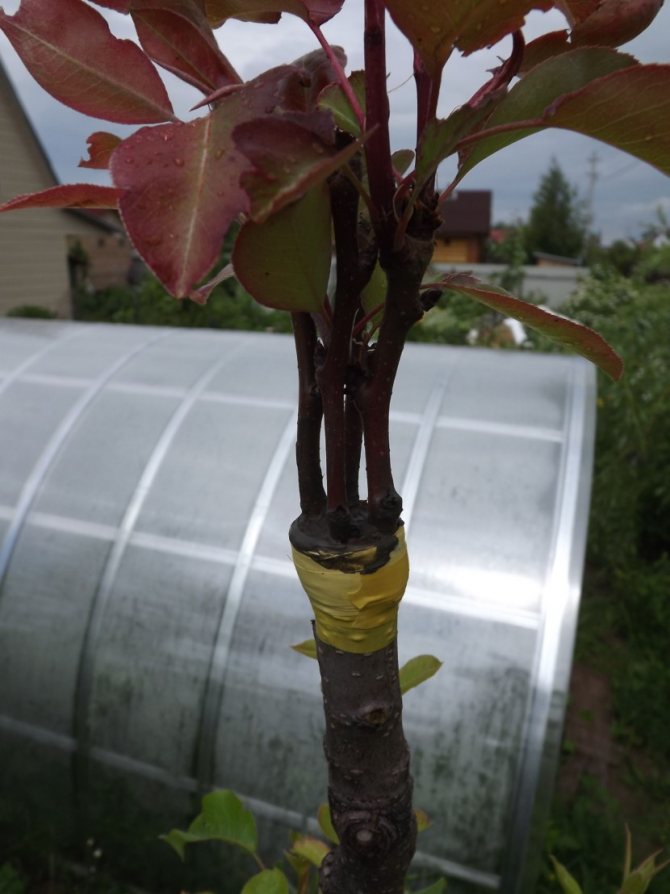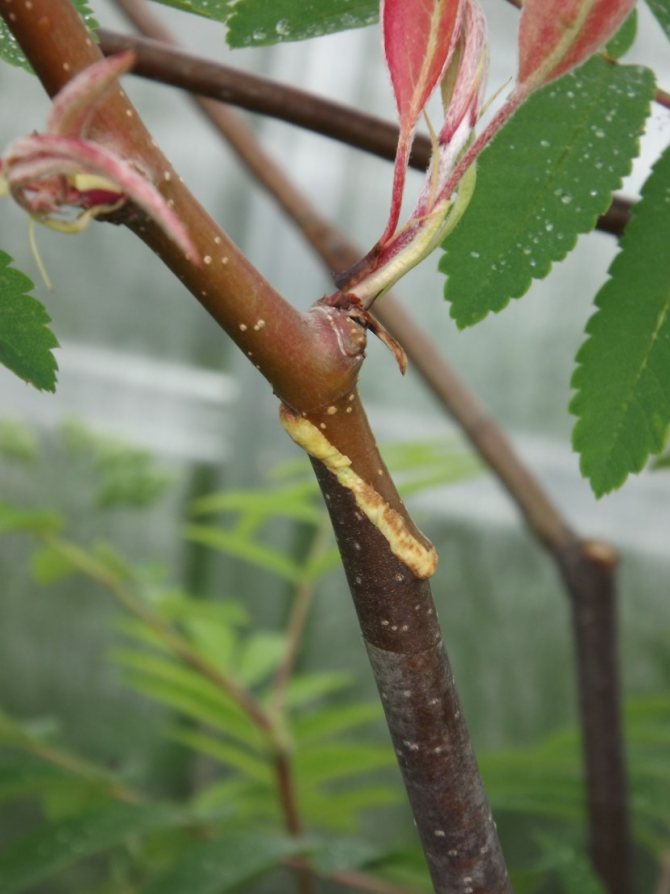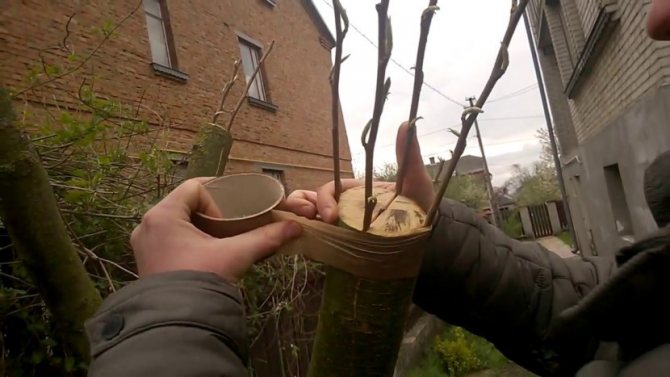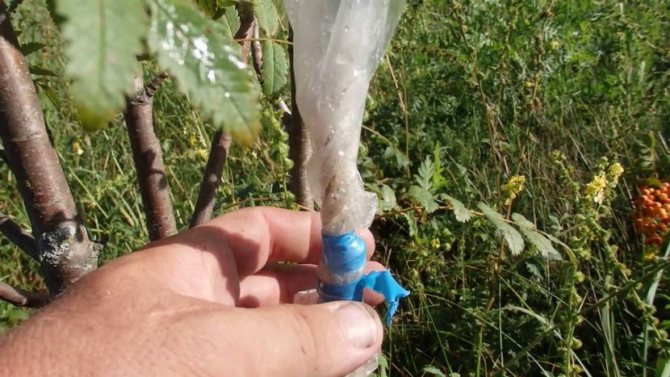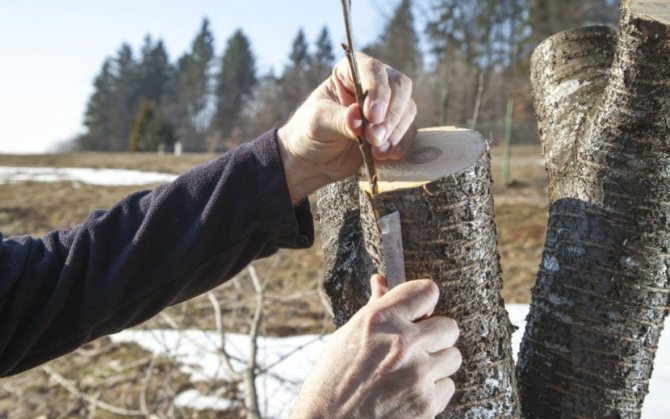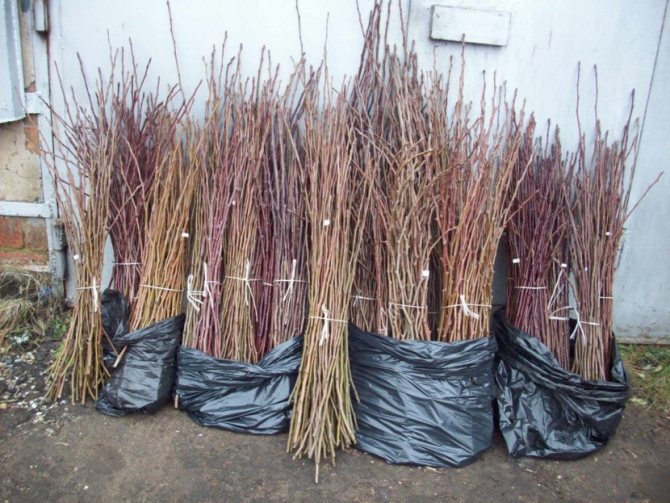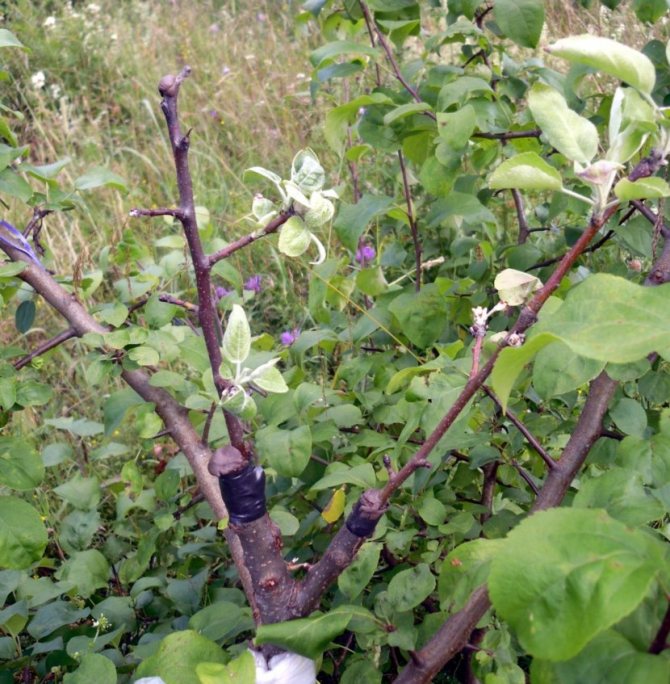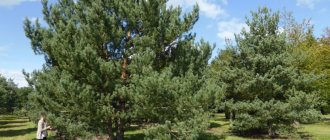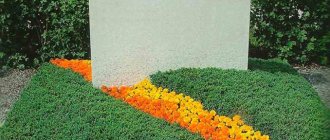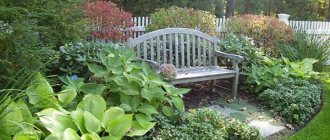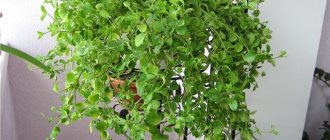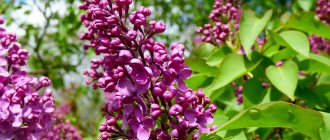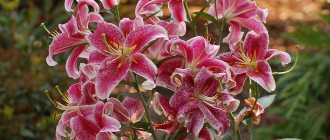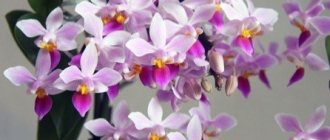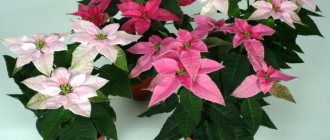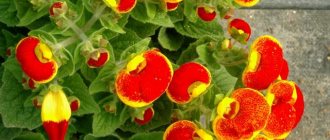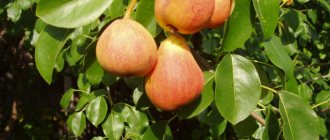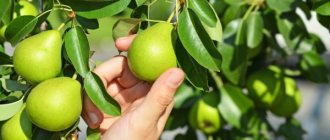Gardening »Pear
0
1526
Article rating
Among summer varieties with stable fruiting, Children's pear is especially popular. It was bred by a breeding institute in Moscow as a result of crossing the summer Duchesse and hybrid No. 8.
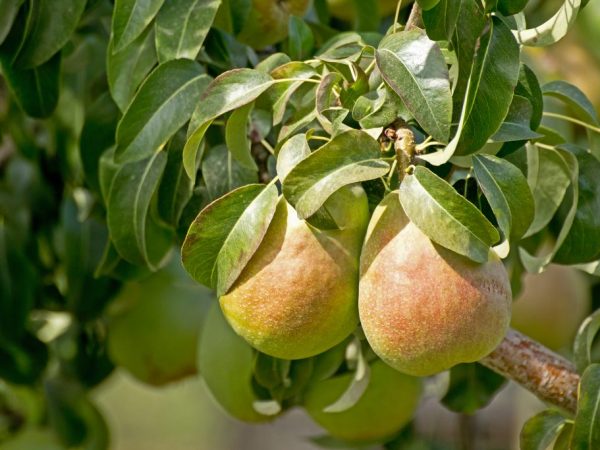
Characteristics of the variety of pears Children's
Description of the pear tree: fruit, crown and flowering
Common pear is a tall tree reaching up to 25 m or a large shrub. The trunk is straight, up to 80 cm in diameter, with wrinkled bark. The wood is durable, solid. The crown is dense, abundantly branching.
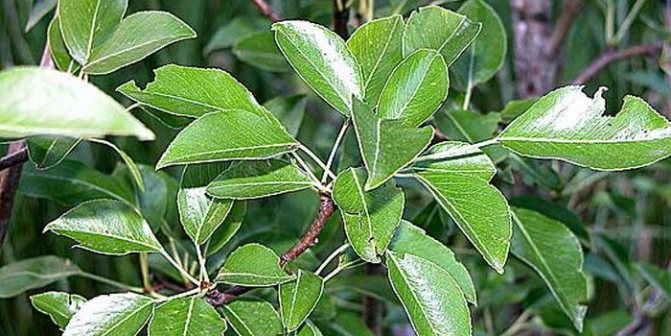

Leaves are round or oval, shortly pointed, leathery, shiny, finely toothed, dark green above, matte below. They keep on long petioles. In the photo of pear leaves, their features are clearly visible.
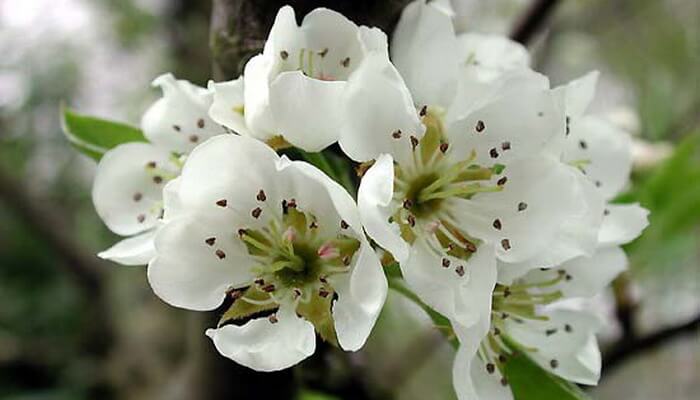

The flowers are large, white or pink, single or collected in inflorescences of 6-12 pieces. They are located on pedicels up to 5 cm long. Formed from last year's fruit buds. They have a white or pink corolla, 20-50 stamens, a pistil with 5 columns. Appear before the leaves open.
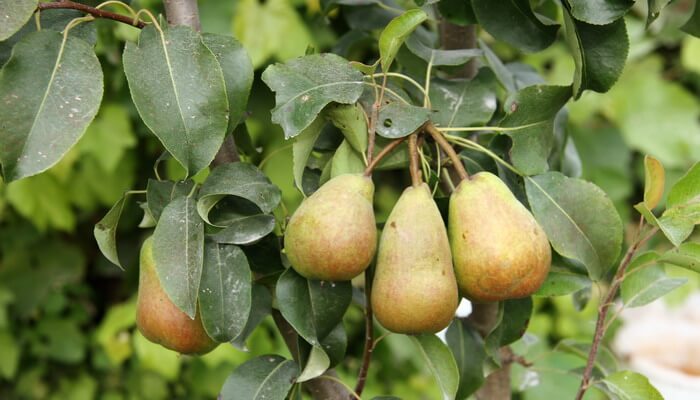

Fruits are oblong, rounded, pear-shaped. The size, shape, color and taste can be different, depending on the variety. The inside of the fruit contains seeds that are covered with a brown skin. Flowering of pears begins at the end of April, lasts until mid-May, and lasts for 10-15 days. The fruits ripen in August-September. Pear begins to bear fruit at the age of 3-8 years.
The life span of a tree is 25-50 years.
When describing the pear tree, it should be noted that all varieties of this culture are self-fertile, therefore, for normal fruiting, the proximity of two inter-pollinating varieties is required. The most popular are the winter-hardy varieties Sibiryachka, Fields, Vnuchka, Povislaya, and Tema. Their fruits have a good taste and are suitable for fresh consumption.
A photo of the pear tree and some of its varieties can be seen in the gallery after this article.
Winter
Saratovka
Obtained as a result of crossing the varieties Bere and Bergamot... They worked on a new variety at the Saratov State Agrarian University named after V.I. Vavilov. Refers to winter, plucked fruits under the right conditions can be stored until February!
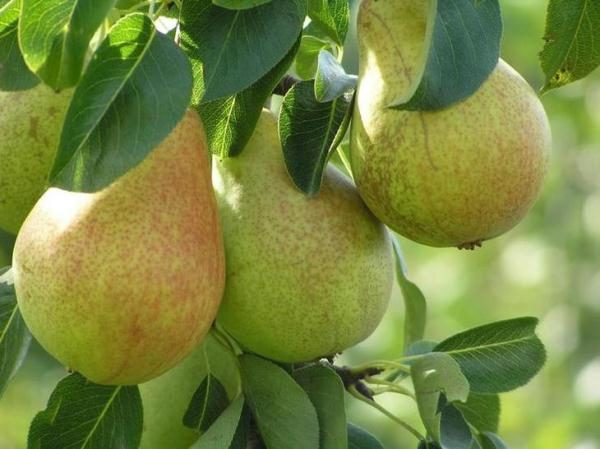

Frost-resistant pear variety Saratovka
Saratovka is a medium-sized variety, the branches look straight up, the tree is more than 10 m high... The crown is dense, the trunk is brown-gray. Young leaves of light green color, oval, with smooth edges. By autumn, they are painted in dark green tones. The disadvantage is the dense crown, which needs proper pruning every year, otherwise, the tree reduces the amount of harvest, more energy is given to the formation of young shoots.
The yield is high, but the tree begins to bear fruit only in the 5th year. The fruits are sweet, firm, with a thick skin, lemon color, with a red-orange blush. It begins to ripen from mid-August, remains on the tree for a long time, until the end of September. The variety is winter-hardy, rarely exposed to diseases and pests, also tolerates long-term transportation, does not lose taste and external qualities.
Kondratyevka
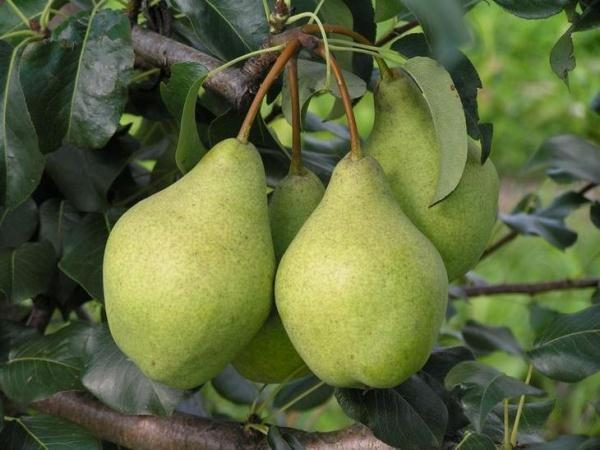

High-yielding pear variety Kondratyevka
Winter pear variety, fruit ripening occurs in early and mid-September.High yields start from 5 years after planting. Gives a bountiful harvest annually, the tree does not need rest. The mass of one pear reaches up to 230 grams... The fruits are sweet, juicy, with delicate pulp and spicy aroma. They have the correct pear-shaped shape and are attached to a thick curved peduncle. They are green when ripe, slightly yellowish.
The tree itself is quite tall, 10-12 m in height, with a pyramidal trunk and slightly drooping branches. The variety differs from others in its slow growth, it mainly builds up green mass. But then it bears a large number of fruits. Survives severe cold quite easily, tolerant of various diseases and pests.
Pass-Krasan
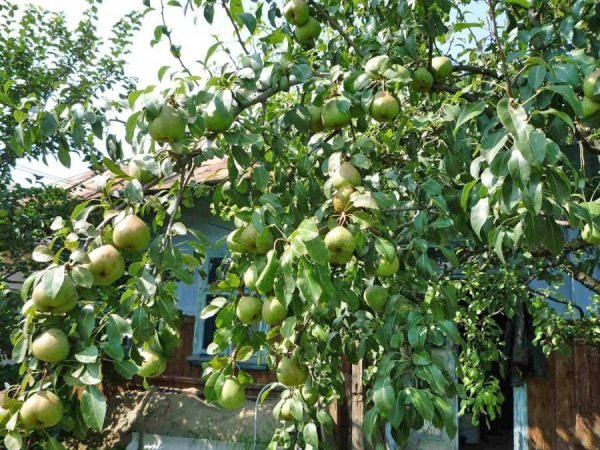

Pass-Krasan pear requires a lot of sunlight
The same applies to winter varieties of pears. Unlike other varieties that do not need special conditions, this hybrid requires increased attention. Prefers to grow only in sunny places, does not tolerate close proximity to other seedlings. From a lack of sunlight, its fruits become sour and do not reach the required size... He also loves moisture and well-fertilized soil. Extremely poorly tolerated cold and susceptible to many diseases.
But subject to all conditions, it gives large, juicy fruits with a slight sour taste. It bears fruit annually, does not require rest, but you should not expect a large amount of harvest from this variety. The mass of one pear can reach more than 200 grams, large pears are light green in color. The right time to harvest is mid to late October, by this time the fruits reach their optimal size and retain their taste. The advantage is the ability of the fruit to last until next spring.
In order for the variety to begin bearing fruit earlier, it is better to graft young seedlings on quince.
May Day
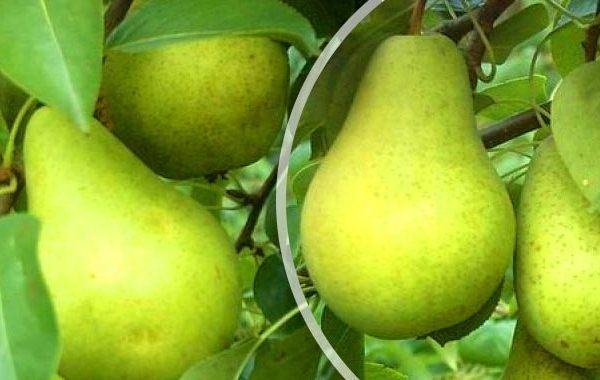

The fruits of the Pervomayskaya variety can last up to 8 months.
The result of crossing pears Daughter of Dawn and Late. This variety differs from others in the storage duration of the plucked fruits, up to 250 days! The pear is not demanding to care for, it is frost-resistant. She rarely gets sick, she doesn't care about many pests. The height of the tree is more than 10 m, with a spreading crown... Young shoots are rather thin, gray-brown, smooth. The leaves are round in shape, with smooth edges, slightly curved upwards.
Average fruit weight from 140 grams, have the correct shape, smooth and thin skin. During the summer, the fruits are green, towards autumn they acquire brown-red tones. Attached to branches with a strong stalk, forming a cluster of 4-6 fruits. Sweet to taste, with a pleasant aroma, slightly tart, with white pulp, has an attractive appearance and taste. The variety has a high yield, but fruiting begins at 5-6 years.
Lyre
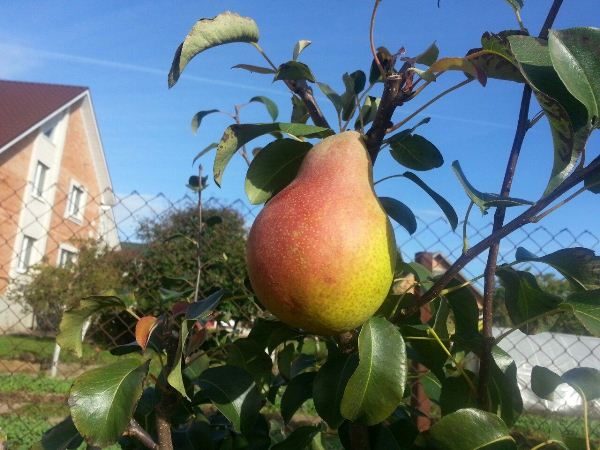

Pear Lear
Winter variety, with a high storage capacity of fruits, up to several months. A tree with a wide pyramidal trunk, light brown in color. Branches of medium thickness, most often gray, smooth. The leaves are elongated, smooth, of dark green shades.
Pear weight more than 200 grams, fruits of greenish tones, acquire a yellowish tint. They have an elongated fruit shape, with a smooth and thin skin. Harvesting can begin from September. The pear is sweet to taste, with white juicy pulp. The yield is high, the tree does not need interruptions, but the harvest begins to appear only 4-5 years after planting. Resistant to diseases and pests, but has an average winter hardiness. Especially young seedlings need additional shelter for the winter.
Patriotic
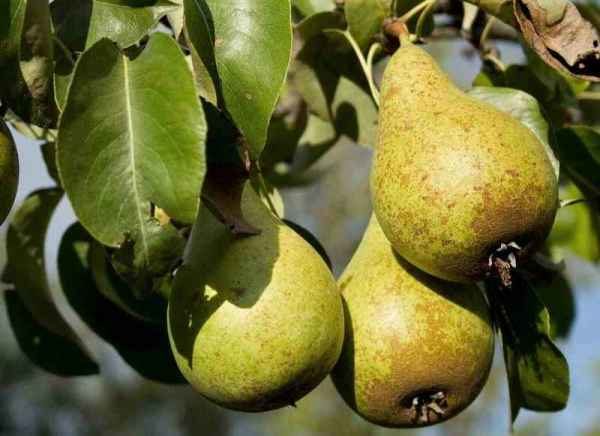

Winter variety of pears Patriotic
The result of the joint work of O.S. Kharchenko, A.V. Krasovsky and A.F. Mileshko. Blooms in late spring, white, rounded flowers with a light aroma. The tree itself is tall, more than 10 m, with a spreading crown, straight branches. The trunk is brown, smooth, regular in shape.
Fruits are large, light green in color, more yellow when fully ripe. Fruit weight up to 180 grams, has an attractive view for sale, also protects the view during long-term transportation. It is recommended to harvest the tree in early October, the fruits can be stored for several months in a cool place. It produces crops regularly, the tree rarely gets sick and is almost not damaged by insects. It is also frost-resistant and does not need special care, it tolerates scab and thermal burns of leaves. Ripe fruits are stored for several months.
For pears to be stored longer, it is important for them to provide the necessary conditions. The fruit must not be damaged or dented when harvested. Also, the pear should be dry and wrapped in newspaper or paper. It is better to store in small boxes, in 2-3 rows. The room should not be damp, too hot and humid. The optimum storage temperature is + 8-14 degrees, in a dark place.
Sprouting
The common pear tree is widespread in Eastern Europe and Western Asia. In the wild, it is found in central and southern Russia, in the Caucasus, Ukraine, Belarus.
Chernozem, gray forest and loamy soils, structural and fertile in their composition, are suitable for this plant. The tree often settles on hills and slopes with good air drainage.
The growth of the common pear in lowlands and closed pits, where cold air stagnates, negatively affects its growth and fruiting.
Fruit trees of pears are moisture-loving, but do not tolerate stagnant water in the soil and excessive waterlogging. Many varieties are drought-resistant and frost-resistant. However, in harsh winters, wood and skeletal branches can freeze. Flower buds are damaged by sudden temperature changes and spring frosts.
Distribution and ecology [edit | edit code]
In the wild in Europe, the pear is widespread up to about 60 ° C. sh. On the northern border of the range, it is rare.
By 2006, as a result of successful selection of frost-resistant varieties, pears are effectively grown in garden plots located in the Urals and Western Siberia up to 55 ° N. sh.
It is believed that the origin of cultivated pear varieties is associated with the hybridization of a number of species, in particular, Pyrus achras Gärtn. , Pyrus persica Pers. , Pyrus cordata Desv. , Pyrus elaeagnifolia Pall. ... Pears were cultivated in ancient Persia, Greece and the Roman Empire.
Currently, there are thousands of varieties of pears.
Pear tree fruit
The pear fruit contains sugars, organic acids, nitrogenous and tannins, pectins, fiber, phytoncides, vitamins A, B1, PP, C. Many varieties contain a large amount of trace elements.
Pear fruits contain less sugar than apples, however, due to their low acid content, their taste is sweeter.
Used fruits in fresh, dried and canned form, are used to make desserts, juices, wine drinks. Compotes are made from dried fruits. Pear juice is rich in tannins, flavonoids, catechins, anthocyanins. Fresh pears are easily absorbed by the body and regulate the digestive tract. A decoction of dried fruits is an excellent thirst quencher.
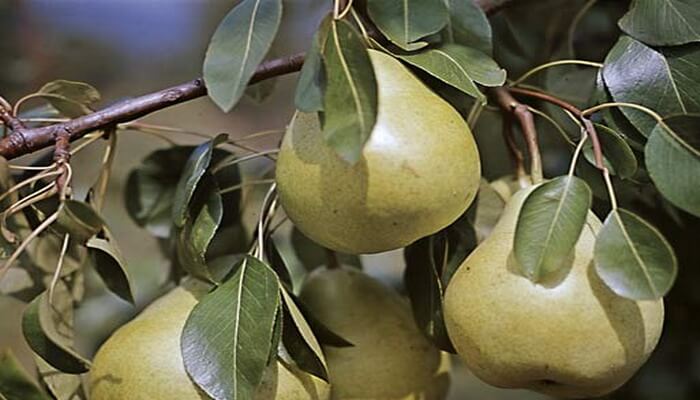

Other photos of pear fruits are presented at the bottom of this page in the photo gallery.
What is important
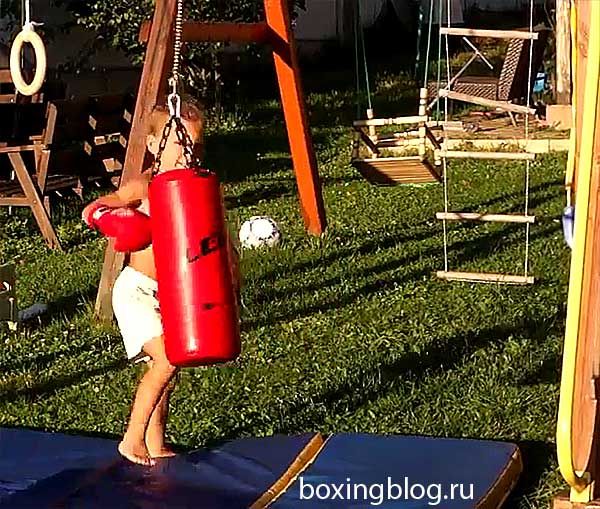

Today, going into sports goods, the attention is offered to an assortment of punching bags with different fillings, and it is the contents that you need to pay attention to. Children's, teenage hand is not yet sufficiently formed, therefore it is important:
- pick up a pear with a softer filling;
- teach the child to properly bandage. Also, many trainers and traumatologists recommend not using a bandage through the phalanges of the fingers;
- buy gloves at least 10 ounces;
- teach the correct formulation of the blow.


Among the most popular fillers used are:
- sand;
- tyrsa;
- wood shavings;
- rags;
- rubber shavings.


The toughest bag is the one filled with tyrsa and sand. Over time, this shell turns to stone. The optimal material for children is rags, leather trimmings, wood shavings.
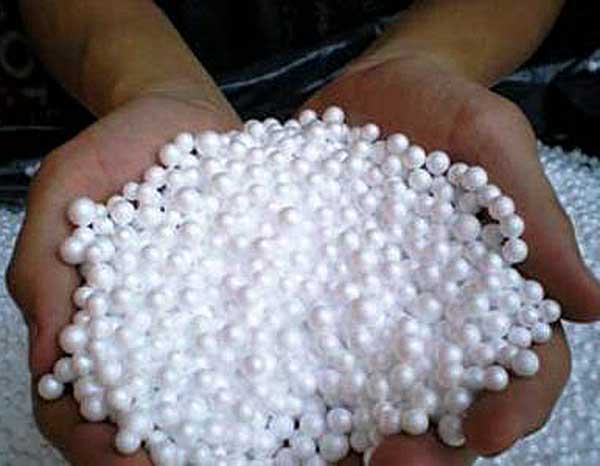

How to choose the right punching bag for a child of 7-12 years old and for adolescents. This is the age of active hormonal rise, a teenager has an incompletely formed skeleton, but has a lot of energy. Often this combination leads to injuries, so the best option would be a hanging and wall pear with a medium-hard filler. Why? Read below.
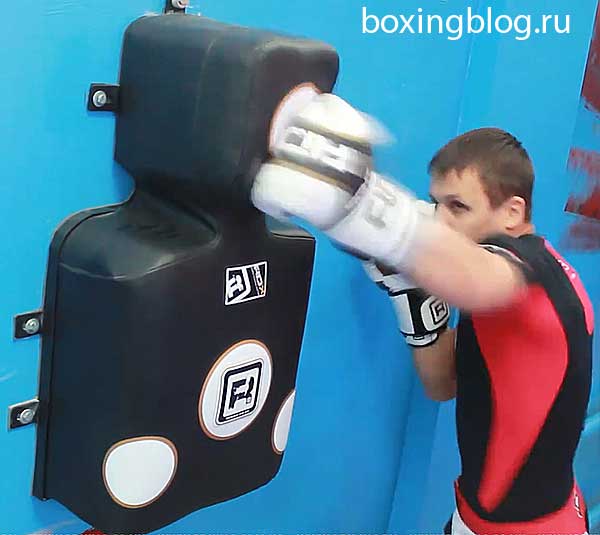

Pear application
The fruits are used in the food industry and in folk medicine. Dried pear seeds are used as a substitute for coffee.
The plant is also used on the farm. This individual is suitable as a rootstock for growing different varieties of pears.
Wood is prized for its durability and beautiful pattern, it lends itself well to processing and polishing. Goes to the manufacture of furniture, musical instruments, rulers, toys and other products. It is very popular with painters and sculptors.
Punching bag and punching bag: what's the difference?
There are many types of both punching bags and boxing pears. Before you start choosing a specific model, you should understand the basic differences.
- Weight. A punching bag and a punching bag have different weights. The bag is a special piece of equipment that weighs significantly more than a pear. The boxing bag contains heavy filler. Accordingly, a pear is much lighter than a bag.
- The form. The boxing bag has an elongated cylindrical shape. The punching bag (as the name suggests) has a teardrop shape.
- Purpose. The bag is versatile. It is usually used to practice all groups of punches and kicks. The functionality of the pear is specific. It is usually used to deliver a series of quick and hard blows.
Having decided on the choice of the type of sports equipment, you can proceed to the purchase of a specific type of pear or boxing bag.
Common pear leaves
Common pear leaves are rich in vitamin C, flavonoids, arbutin glycoside. They are a medical drug prescribed to combat fungal diseases and dermatitis.
The flowers of this plant give off a lot of nectar. From one hectare of pear orchards, you can collect up to 25 kg of honey and a large amount of pollen.
The common pear is a valuable decorative tree, therefore it is planted in personal plots, in parks, squares, along roads.
The photo of the pear below testifies to this:
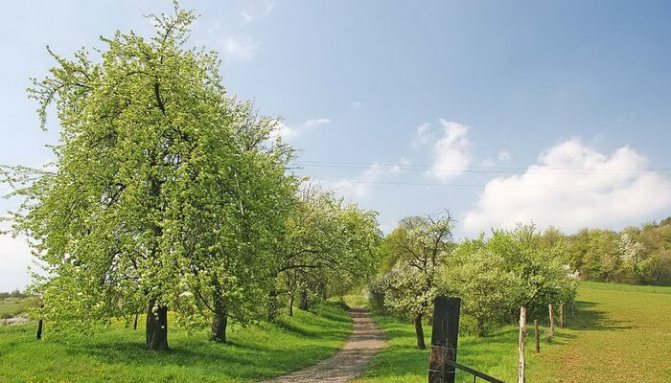

Pruning
Children's pear is a variety that requires shaping and pruning. It begins after planting the seedling for this, the top of the central trunk is cut off at the level where the tree will begin to form a crown. Gardeners practice doing this at a height of 1.3-1.5 m. A cut is made over a developed bud with a sharp pruner, then covered with garden pitch.
The next pruning is carried out in the spring before the onset of sap flow and swelling of the buds. By pruning, branches of 2, 3 and subsequent levels are gradually formed.
Pruning of mature pear trees is carried out every spring. Correct the shape of the crown, cut out old and dried branches, and also clean out the branches that grow inward and thicken the crown. All sections are carefully covered with garden var.
With the help of pruning, you can not only form a beautiful tree, but also protect it from the development of fungal diseases that occur when the crown thickens and poor ventilation.
Pear crown formation: video and description
The crown of a pear is pruned periodically. The qualitative growth of the plant, the nature of fruiting and the yield of the tree depend on a properly formed crown. The formation of the crown of a pear begins in the first years of the tree's life. This work is carried out in two ways: by cutting and bending the branches. When pruning, shoots are shortened and branches are thinned.Shortening shoots helps to awaken new buds and form shoots. When shortening annual shoots, the cut is made above the bud. After thinning the branches, the illumination inside the crown improves, which leads to the formation of more flower buds.
The bending of the branches helps regulate the growth and development of the tree. In order to accelerate fruiting, the main branches are deflected from the trunk at an angle of 50-60 °. Small branches are transferred to a horizontal position, while their ends should be located slightly above the beginning of the main branch. The bending of the branches is carried out using a wire, the attachment points are wrapped with electrical tape so as not to damage the bark.
In some cases, the skeleton of the crown is formed during transplantation of the seedling to a permanent place. For seedlings that do not have branches, the cut is made above the bud at a distance of 70 cm from the ground. From the remaining buds, lateral shoots are formed, from which they form the first tier of skeletal branches.
Old trees need rejuvenating pruning, when the fruits have been significantly crushed, and the annual growth of shoots is 10-15 cm. With rejuvenating pruning, all old branches are removed, skeletal and semi-skeletal branches are pruned. Annual shoots are cut, leaving 2-3 lower buds. After that, highly developed shoots grow on the tree. Some of them serve as a substitute for skeletal branches, other shoots are transferred to fruiting. The branches thickening the crown are cut out. After rejuvenating pruning, the tree needs enhanced care: abundant watering, feeding and treatment from pests.
The video will tell you in detail how the formation of the pear crown is carried out:
Autumn
Autumn garden varieties differ from others in the long term storage in assembled form, they are not inferior in taste to summer or winter ones.
Veles
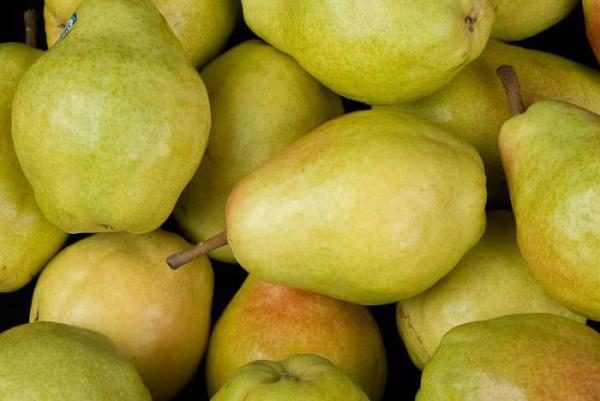

Veles pear variety
Autumn pear variety, one of the best. The fruits are large enough, the average weight of a pear is from 150 grams and above... Fruits are regular pear-shaped: narrow at the stalk and rounded at the bottom. On the branches they grow in small clusters, 3-4 pears each. The Veles pear ripens at the end of August, remains on the tree until October. It has a beautiful appearance, until the end of summer the fruits are dark green, and when ripe, they become red-orange tones. The taste is sweet, juicy, with fleshy pulp and thin skin.
The height of the tree is no more than 8 m, with drooping branches and a pyramidal shape of the trunk, gray-brown in color. Young branches are formed throughout the summer, which affects the amount of the harvest; it is recommended to prune in the fall. Resistant to frost, disease and pests.
Bere Moskovskaya
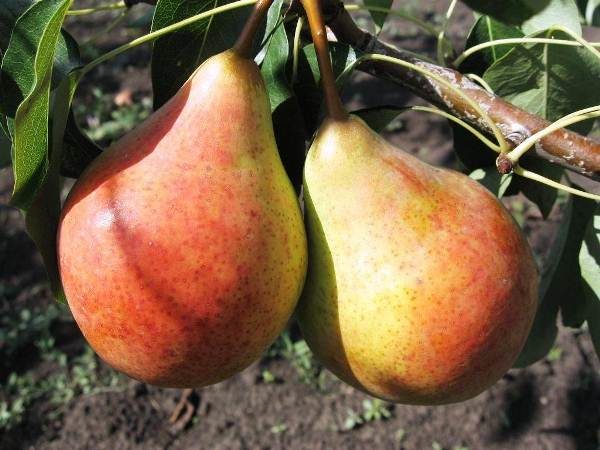

Bitter-tart pear variety Bere Moscowskaya
Frost-resistant, almost not exposed to diseases and pests. It appeared as a result of pollination of the Olga variety with pollen from the Lesnaya Krasavitsa and Lyubimitsa Klappa varieties. A tree no more than 6-8 m high... The crown of the pear is round, light brown in color. Young branches are rather thin, drooping, gray or brown in color. The leaf plate is dark green, rounded. The pear blooms in early spring.
Fruits are slightly bumpy, light green shades, there is a slight blush closer to autumn. It is best to remove fruits that are slightly green and firm in early autumn., so they keep better and stay longer, up to several months in a cool and dark place. If the pear tastes slightly tart, with sourness, it means that the pear lacks moisture. With proper care, the pear becomes sweet and fleshy, with a delicate white flesh. In general, this variety is not capricious when leaving.
Red-sided
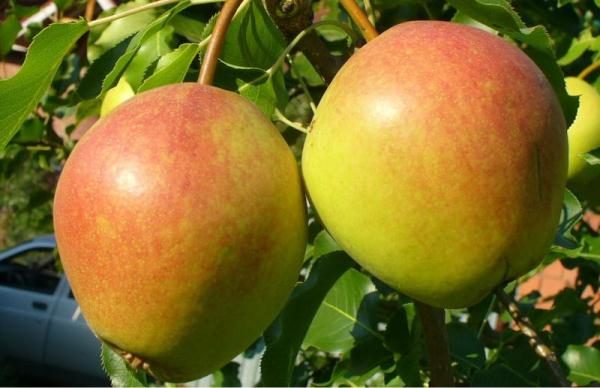

Pear variety Red-sided
The misconception that this variety belongs to the winter, it is not, the variety is autumn ripening. It was obtained as a result of crossing the varieties Zheltoplodnaya and Tenderness. Resistant to diseases and pests, especially scab... It is frost-resistant, gives a good harvest from year to year. The crown is rounded, the branches are slightly drooping, brown-gray in color.Leaves are slightly pointed, light green shades in spring and dark green tones closer to autumn.
Does not require special care, can grow in small shade, under taller trees, but loves moisture. Fruits of medium size, weighing no more than 200 grams... Green pears change their shades to a raspberry blush as they ripen. Sweet to taste, with juicy fine-grained pulp and thin skin. Stick to branches, on short, curved stalks. The fruits are able to survive for a long time, both on the tree and in the assembled state, they are not afraid of transportation.
In memory of Yakovlev
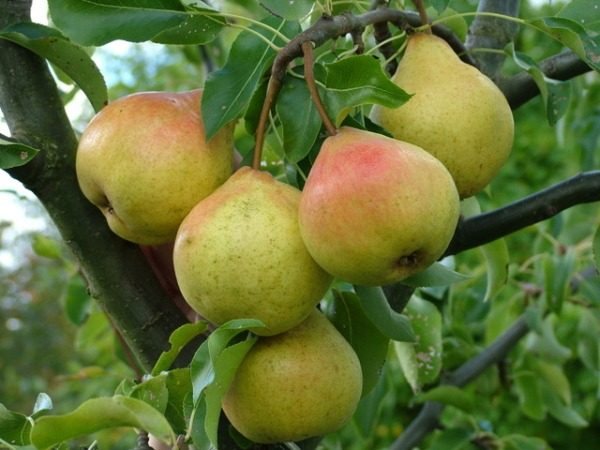

Pear variety of high winter hardiness in Memory of Yakovlev
A medium-sized tree with a dense crown. The height of the tree does not exceed 1.5-2m, with a spherical crown. Young branches are thin, looking up, brown-gray in color with small thorns. The leaves are dark green, ovoid, with smooth edges. The harvest gives for 6-8 years... The Pamyati Yakovlev variety is popular among gardeners due to regular fruiting and unpretentious care.
Pears with smooth and thin skin, weighing no more than 200 grams. The fruits are collected in groups of 5-7 pears. The pear is sweet to taste, with juicy pulp and pleasant aroma. The fruits are golden in color, slightly reddish at the end of ripening. Full ripening of fruits occurs in mid-October.... The pear is stored on the tree for a long time, does not fall off, and in the assembled state it can lie for several months. High yield, which increases every year the tree grows. More than 30 kg of ripe pears are harvested from an adult tree per year. In addition, it is capable not only of self-pollination, but also pollinates other varieties of pears. It greatly simplifies the care of a pear that it is winter-hardy and unpretentious in care.
For the first time the word "pear" was mentioned in chronicles in the 12th century, and sounded like "hrusha". And all, because of the characteristic crunch, which was published when biting the fruit.
Muscovite
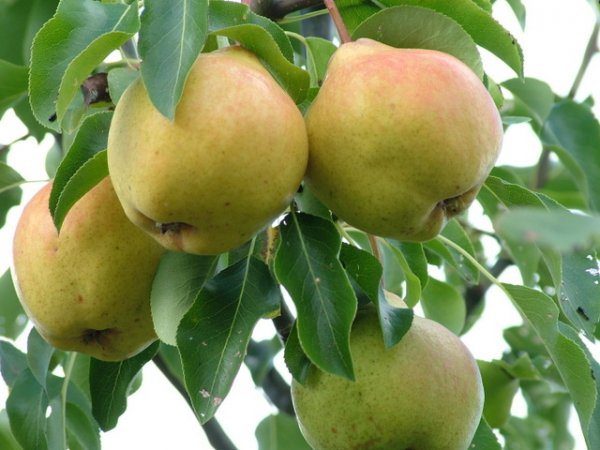

Branch of pear Moskvichka with fruits
Obtained as a result of pollination of one of the American Kieffer pear varieties. Possesses a standard shape, with a rather dense and spreading crown, light gray colors, which eventually changes shades to brown tones. Forms new curved shoots quickly. The foliage is light green in color, with an oval shape, slightly curved in the center. This variety produces a bountiful harvest in the southwestern regions. The first harvest is formed in 3-4 years.
Muscovites are medium-sized fruits, up to 150 grams. They have the correct pear-shaped shape. They have a greenish-yellow hue, which changes towards burgundy-crimson tones by the end of summer. The skin is thin, fleshy with a juicy pulp with a pronounced sweet-sour taste. It is recommended to pick pears when they are slightly underripe, because after lying in the room for a couple of days, the pear ripens and retains its taste. Under the right storage conditions, the fruits are able not to spoil for several months.... High resistance to scab and rot, also not afraid of frost.
Marble
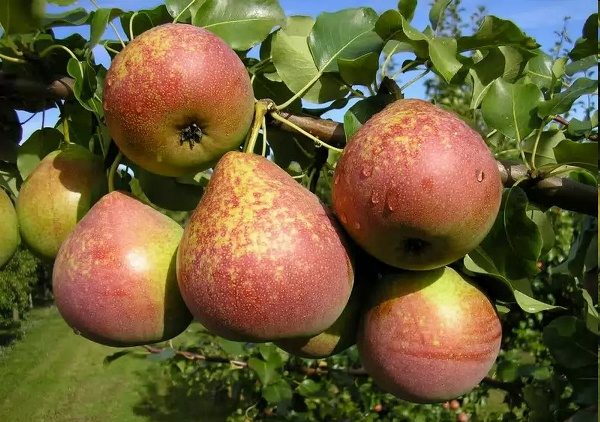

Marble pear fruits
The fruit of the crossing of Bere Zimnaya Michurina and Lesnoy Krasavitsa varieties. The harvest of this variety ripens by the very beginning of autumn, the first fruits can be picked at the beginning of September. Differs from others in the height and density of the crown, the height of the tree is more than 8 m... Many light brown thin branches are formed every year, but pear shoots are extremely rare. Blooms in early spring with white fragrant inflorescences. The foliage is dark green in color.
The fruits are large, from 170 grams, with yellowish-green hues and a slight blush. The pear is also distinguished by the correct conical shape of the fruit. The pulp is coarse, tender, juicy. Rather dense rind, with small dots of a rusty color. The Marble variety, like other autumn pears, is frost-resistant, not afraid of diseases and pests. The tree begins to yield only 5 years, but the yield percentage is high, the pear is able to please with a large amount of harvest every year.
A bit of history
The cultivated varieties of this plant originated from the wild-growing common pear.The individual began to be cultivated in Ancient Greece by selecting large and sweet-fruited species. Pear fruit trees were brought to the territory of Russia from Byzantium. Initially, the plant was bred in the monastery gardens. In the garden of Tsar Alexei Mikhailovich Romanov, there were about 16 varieties of pears. Peter the Great tried to increase the varieties of varieties in Russia, therefore, according to his decree, new seedlings were imported from Western Europe every year. Today there are more than 5,000 varieties of this culture, differing in taste, color, ripening period of fruits, shape and size.
Classification [edit | edit code]
The genus includes 69 species [8], which are distributed in two sections Pashia
and
Pyrus
[9] .
- Pyrus armeniacifoliaT.T.Yu
- Pyrus betulifoliaBunge
- Pyrus calleryanaDecne.
- Pyrus cossoniiRehder
- Pyrus dimorphophyllaMakino
- Pyrus fauriei C.K. Schneid.
- Pyrus hondoensis Nakai & Kikuchi
- Pyrus koehnei C. K. Schneid.
- Pyrus pashiaBuch.-Ham. ex D.Don
- Pyrus pseudopashiaT.T.Yu
- Pyrus pyrifolia (Burm.f.) Nakai - Pear-leaved pear
- Pyrus taiwanensis Iketani & H. Ohashi
- Pyrus ussuriensis Maxim. - Ussuri pear
- Pyrus xerophilaT.T.Yu
- Pyrus boissierianaBuhse
- Pyrus communisL.typus [2] - Common pear
- Pyrus communis L. subsp. caucasica (Fed.) Browicz [syn. Pyrus caucasica Fed. - Caucasian pear] basionym
- Pyrus communis L. subsp. pyraster (L.) Ehrh. [syn. Pyrus pyraster (L.) Burgsd. - Forest pear]
- Pyrus cordataDesv.
- Pyrus elaeagrifoliaPall. - Shaggy pear
- Pyrus gharbianaTrab.
- Pyrus glabraBoiss.
- Pyrus korshinskyiLitv.
- Pyrus mamorensisTrab.
- Pyrus regeliiRehder
- Pyrus sachokianaKuth.
- Pyrus salicifoliaPall. - Willow pear
- Pyrus spinosaForssk.
- Pyrus syriacaBoiss.
- Pyrus turcomanicaMaleev
Pear production, 2016
| Country | Products thousand tons | |||
| China | 19388 | |||
| Argentina | 906 | |||
| USA | 739 | |||
| Italy | 702 | |||
| Turkey | 472 | |||
| South Africa | 433 | |||
| India | 399 | |||
| Netherlands | 374 | |||
| Spain | 366 | |||
| Belgium | 332 | |||
| Peace | 27300 | |||
| Food and Agriculture Organization of the United Nations [10] | ||||
Photo gallery
Diseases and pests
Pear "Children's" resistant to various fungal diseases. But it can be damaged by various insect pests - a pear moth, a pear mite, a pear honeycomb (leaf beetle).
Chudesnitsa, Svetlyanka, Bere Bosk, Tatiana and Svarog are resistant to major diseases.
To combat them, use drugs of insecticidal action. These include "Karbofos", "Metaphos", "Kelifos", etc..
Spraying should be carried out on a dry, windless day... This is done in the spring, before bud break. This will help get rid of pests hibernating under the tree and in its bark. After a while, the tree is sprayed again.
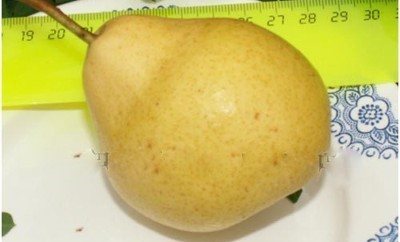

Pest insects reproduce very quickly. Several generations can form over the summer. They gnaw the leaves, spoil the fruits, branches and shoots of the tree.
If you do not fight insects, the tree will begin to wither and subsequently may die.
In order to protect your garden from pests, preventive measures must be taken annually. The bark, leaves and fruits of the tree should be constantly examined.
For any changes in their appearance, it is worth spraying the pear. Preventive spraying also helps in the fight against various pests.
In the fall, you need to collect all the fallen leaves and burn - most pests hibernate in fallen leaves. You also need to dig up the near-trunk circle and dig deeply in the soil close to the tree.
The first five years of the tree's life, until the bark on the trunk got stronger, it is necessary to protect trees from rodents. To do this, the wood stem is wrapped with dense material. For example, tar. But the trunk must first be wrapped with newspapers so that it does not come into contact with the bark of the tree.
- Fruit mite This insect sucks out all the nutrients from the leaves of the tree. The leaves begin to dry out and fall off.
This negatively affects the formation of fruits and the development of the tree in general.It is necessary to spray from this pest during the growth of buds with the drug "Karbofos" or another insecticide.
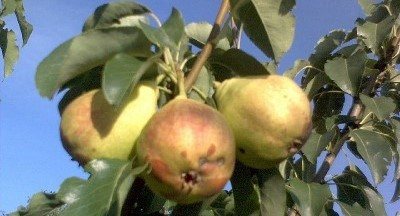

Pear mothIt is a small butterfly with dark front wings.
She lays eggs inside the fetus.
The variety "Detskaya" is ideal for its activity, because The moth is dangerous for summer varieties of pear - the fruit has a soft skin and it is easier for it to penetrate inside.
Damaged fruits dry and fall off.
To combat the butterfly, it is necessary to use various insecticides, in the fall, dig up the trunk circle and burn the fallen leaves, where the pests go for the winter. Can be treated with benzophosphate.
- Winter moth It lays eggs in cracks in bark and branches or near buds. Yellow-green caterpillars appear before the flowering of the tree.
They feed on pear leaves, flowers and buds.To combat the peppered moth, insecticide treatment is used before the flowering of the tree. - Pear Copper It is a small fly. Adults and their larvae suck out cell sap from the leaves and peduncles of the tree.
As a result of their activity, flowers die off, the ovary falls off and the pear leaves dry out. To destroy it, insecticide is also used.
Harvest storage
Autumn and winter varieties are kept at home for the longest time. Store pears in a cool dry place. A wooden box or plastic container is suitable for storage. The main thing is that there are openings for air access. The bottom and walls of the container should be laid out with paper. Before laying, all fruits must be checked for visible defects. One defective fruit can spoil the entire contents of the container. Fruit, prepared for long-term storage, must have the stalks preserved. Fruits of different varieties should not be placed in one box, and the number of layers should not exceed two.
Rootstock selection
Pure pear dwarfs have not yet been bred. They are obtained by grafting a special rootstock. The following trees are most often used as rootstocks:
- Common quince;
- Anzherskaya irga;
- Provencal irga;
- cotoneaster;
- chokeberry.
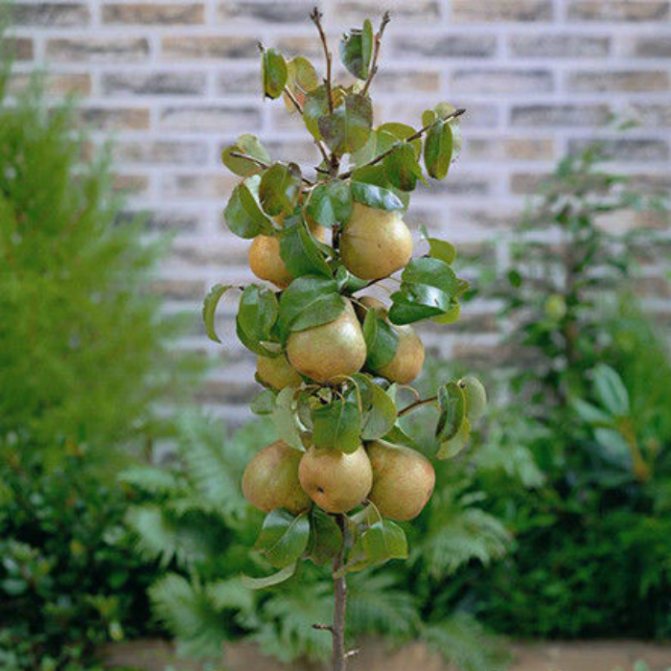

Dwarf pear
In the absence of the listed species, vaccination can be done on hawthorn and mountain ash.
When choosing a stock, its susceptibility to climatic conditions should be taken into account. The most common rootstock is quince. However, it has poor frost resistance.
The use of cotoneaster is popular in the northern regions. The cotoneaster has good frost resistance.
Important! When planting a grafted tree, the lower part should be hidden in the soil to the grafting site. This will help withstand low subzero temperatures and winters with little snow.
Planting pears. How to plant a pear?
An important step is the correct choice of a place for planting pears and careful preparation of the planting pit. For planting, one- or two-year-old pear seedlings with a developed root system and no visible damage to the aboveground part are used. Spring planting of a pear is permissible, although experts recommend planting a pear in the fall - in mid or late September, when the saplings of the seedlings have fallen out of leaves and sap flow has stopped.
The best soil for planting pears is clay and loamy, with deep groundwater. Acidic soils are preliminarily limed. A place for planting a pear seedling is chosen sunny and protected from the winds.
A landing pit 1 m wide and 80 cm deep is dug in advance. At a distance of 30 cm from the center, a stake is driven in, which is necessary for the correct growth of the tree.
8-10 kg of rotted manure or compost, 50 g of superphosphate, 30 g of potassium salt are introduced into the pit and mixed with a small amount of earth.
A pear seedling is placed in a hole and earth is added, periodically shaking the tree itself. When properly planted, the root collar will rise 6-8 cm above ground level. Then the soil is trampled down tightly and spilled with several buckets of water. The trunk of a pear seedling is tied to a peg and, at the end, the trunk circle is mulched with humus or manure so that the mulch does not touch the tree trunk.
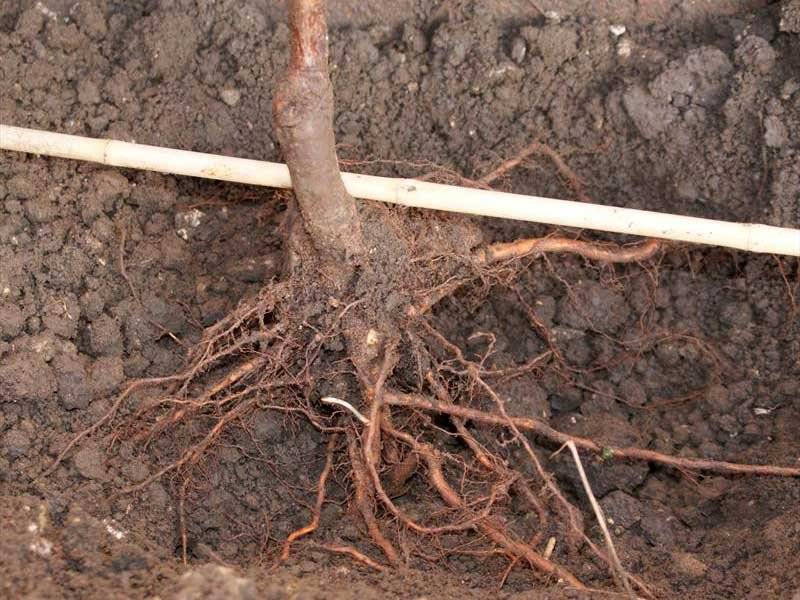

Bere Giffard
Belongs to the early maturing French varieties. The difference from other varieties lies in the “rosy color” of the fruits: one side is red-orange, the other is light green. The formation of pears on a branch occurs in clusters of two to six pieces. An abundance of fruit often requires the installation of props.
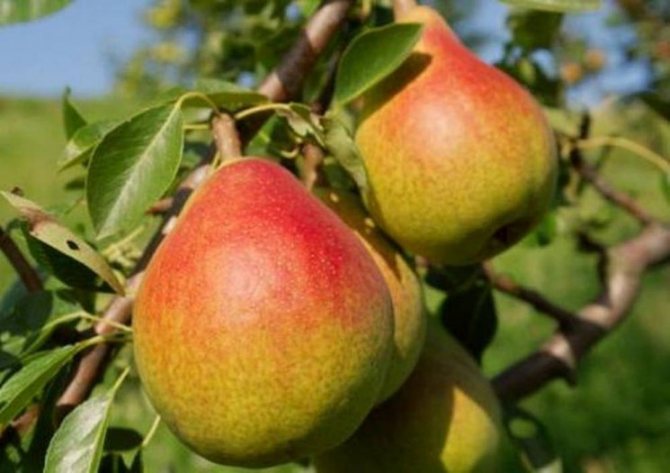

The pulp is dull white, of the most delicate texture and a high degree of sweetness. In height, the plant can exceed the 10-meter mark. Crohn's rare. The branches are slightly drooping and rather thin. The brown bark is prone to peeling. Dark green oblong leaves have smooth edges.
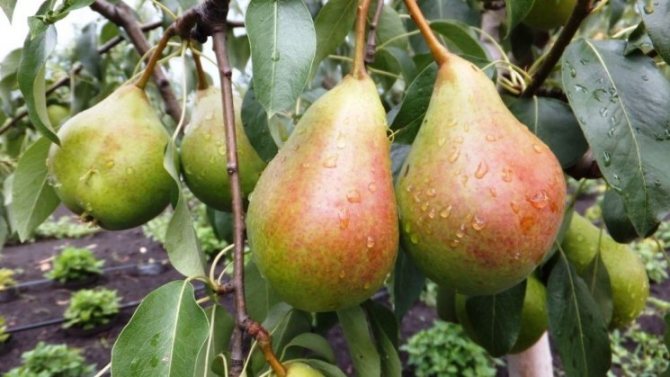

The variety does not have good frost resistance, as a result of which young trees require shelter.Plucked fruits are practically not stored - they disappear within a week.
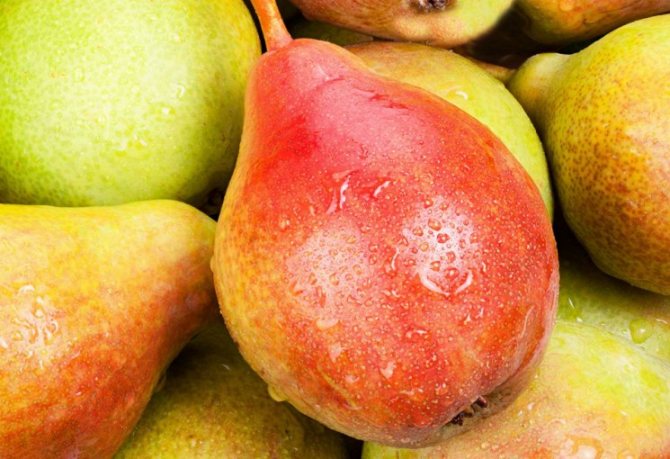

Winter hardy varieties
When choosing a pear variety for gardeners in most regions of our country, its winter hardiness is a decisive factor. The following representatives of this culture are most easily tolerated by a strong drop in temperature:
- Lada;
- Severyanka;
- Granddaughter;
- Siberian;
- Small;
- Krasnoyarsk large;
- Apple-shaped.
Lada
An early summer variety included in the State Register for the Central Black Earth, Middle Volga and Central regions, with medium-sized standard trees. They bring the first pears 3 years after budding. Fruits of Lada are obovate, smooth. Their weight rarely exceeds 110 g. Lemon skin, with a reddish tan and slight rustiness at the base of the peduncle. The pulp is sour-sweet, fragrant, with a fine-grained structure.
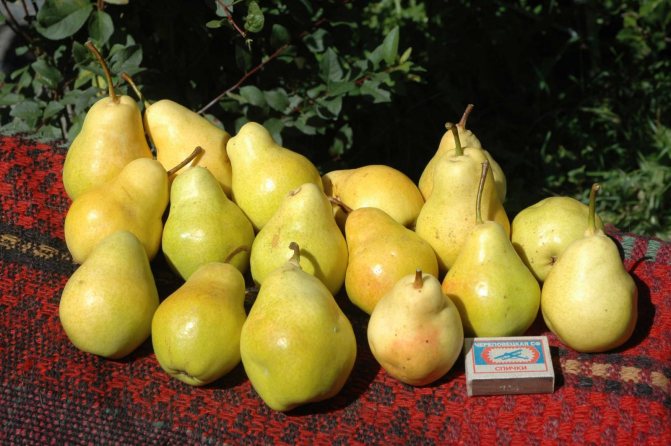

Lada fruits have a universal purpose
Under favorable conditions, up to 50 kg of universal pears are harvested from one plant, which practically do not tolerate transportation. At 0 °, their shelf life reaches 60 days.
The Lada variety is highly resistant not only to low temperatures, but also to other whims of the weather, as well as to the main diseases of the pear, including scab and fire blight.
The pear tastes good, but if you overexpose it on a tree for several days, it tastes like a potato
Anona
Small
A highly productive variety of the Krasnoyarsk selection, which is not inferior in cold resistance to semi-cultivated forms, but significantly surpasses them in taste. Zoned in Siberia and the North-West region.
Small trees are medium-sized, well tolerant of dense planting. The fruits are small, almost round. The skin is greenish, with a brownish-red tan. The pulp is sweet and sour, aromatic, fine-grained, with a high content of juice.
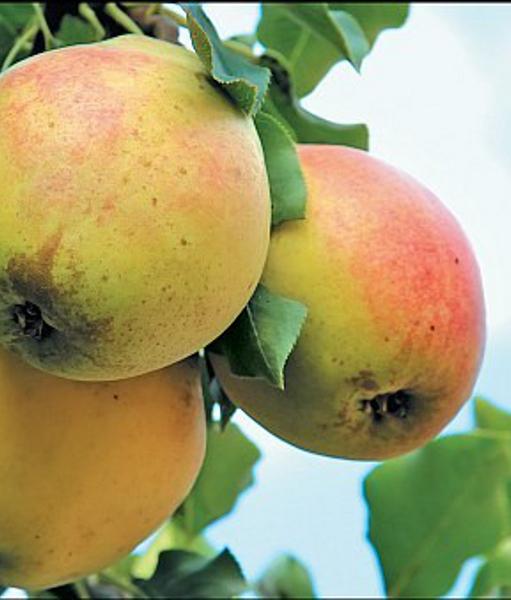

Small fruit weight does not exceed 46 g
Small fruits are removed in September. When overripe, they immediately crumble. Pears picked in time are well transported and stored for about a month. They are eaten fresh and canned.
The first pears are brought in by Little Little Pears not earlier than 6 years of cultivation. Resistance to spotting and scab is relative.
Vaccinations
Before you vaccinate the pear, you need to prepare: a month before the start, carry out hilling about 15 centimeters, and a couple of days before starting, remove the earth from the stem, water.
- usual copulation;
- improved;
- under the bark;
- into cleavage.
Breeding novelties
Breeding new varieties of pears takes a lot of time. You can get the first harvest of the fruits of this crop only 3-4 years after planting, and sometimes even later. She will need several more years to fully reveal all her qualities. But despite all the difficulties, breeders are constantly working to create new forms of pear. Over the past decade, more than 15 varieties have been added to the State Register of the Russian Federation... Including:
- Abafet. Autumn, table variety of pears obtained by specialists of the Crimean Fruit Company by artificial selection from the population of Abbot Fetel. It is a medium-sized tree with a drooping crown and greenish-yellow fruits with a slight pinkish tan, weighing about 200 g. The pulp is very juicy, sweet and fragrant. About 40 tons of pears are harvested from one hectare of Abafet's plantings, which tolerate transportation well. The variety is approved for cultivation in the North Caucasus region. According to the organizer, it tolerates drought and winter cold well in the steppe zone and is resistant to scab and powdery mildew. The first fruiting of Abafet usually occurs in the second or third year after planting in a permanent place.
- Alexandra. A late summer variety included in the State Register as a crop recommended for cultivation in the Middle Volga region. It is characterized by trees of medium size and one-dimensional, pear-shaped fruits, colored greenish-yellow, with a brownish-red tan color.The pulp is juicy, with a sweet, spicy taste and unobtrusive aroma. About 8 tons of pears are harvested from one hectare of Alexandra's plantings.
- Bryansk beauty. A late summer variety obtained at the Kokinsky stronghold in the 90s of the last century and recommended for cultivation in the Central region in 2010. Despite such an insignificant age, he has already managed to gain popularity among gardeners due to such qualities as: resistance to frost (up to -35 °);
- tolerance to pests and infectious diseases;
- oily consistency of juicy pulp;
- pleasant aroma and sweet taste;
- an attractive appearance of large, golden pears with a light burgundy blush.
About the Bryansk beauty, I would like to add the following: this variety must be ripened. In our area, you need to cut it off in the region of August 15 and put it in the cellar for storage. After about a week, you can eat, the pulp is already softening, but the color is still green. Two weeks after picking, the pears turn yellow, the flesh becomes very tender, melting and tasty (that's when it gains its legitimate 4.7 points for taste) and for about a week they "live", then the flesh begins to turn brown and the pears "flow". Total, in my conditions, three weeks of storage, two for consumption. If the storage is refrigerated, you can probably extend the storage up to 2 months.
Alex6579
Sapphire
Belongs to the autumn category. The height of the tree is no more than 2 m. Characteristic features are the decorative appearance of the crown, the almost complete absence of lateral branches, oblong in the shape of the fruit. The pulp is pleasantly sweet, juicy, aromatic. The peel is green-yellow in color. The month of fruiting is September.
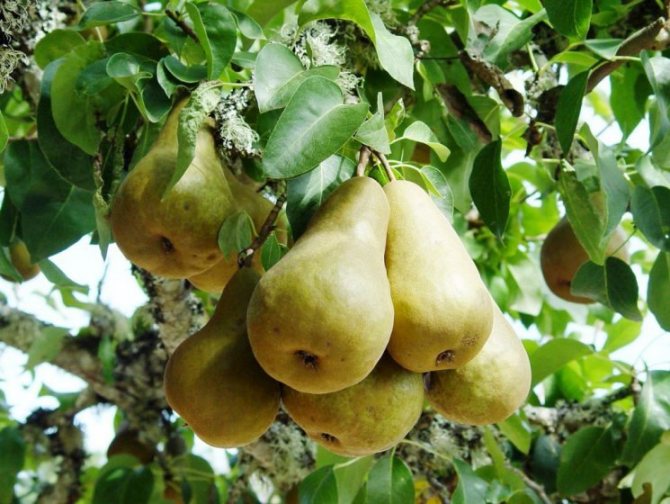

Trees tolerate cold weather well and are immune to most fungal diseases. But they are self-fertile and require pollinators. Fruits are formed only when organic matter is introduced into the soil.
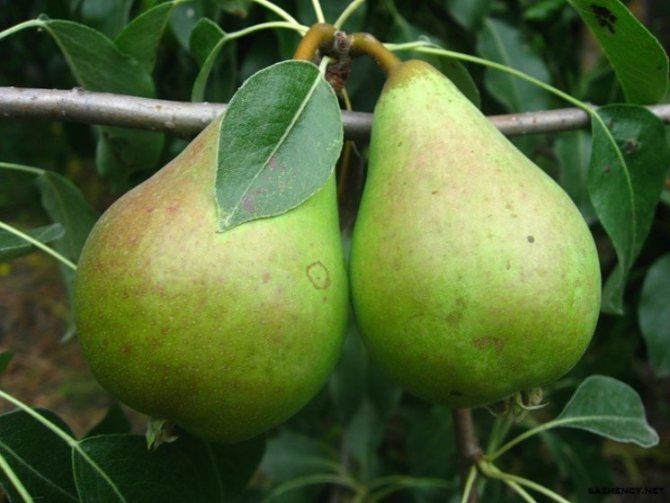

Beauty Chernenko
This early ripe autumn pear was obtained by crossing the varieties Bere Ardanpon and Daughter Blankova. The recommended growing region is Central. The harvest is stored for up to 2 months.
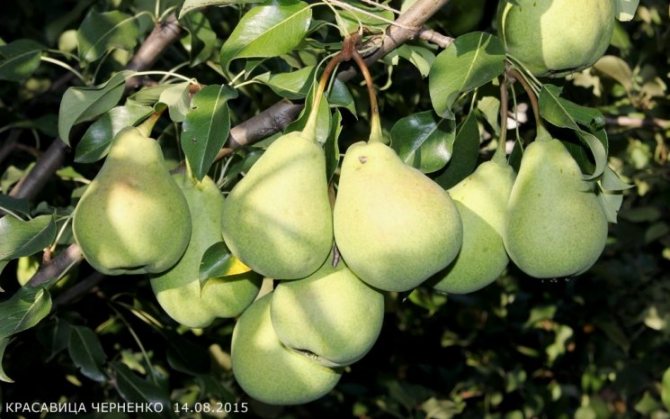

The beauty pear variety belongs to tall species with a rare crown shape - narrow pyramidal. The bark is smooth, brown in color. The branches grow vertically upward. The leaves are large, elongated, serrated, dark green.
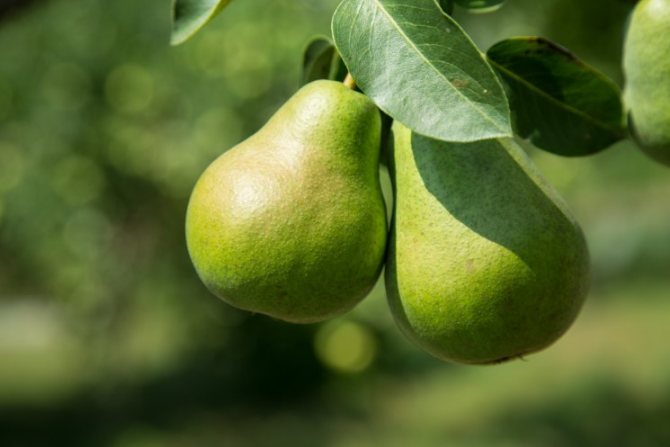

The fruits are heavy, weighing 165-180 g, green-yellow in color with a brownish blush. The skin is of moderate density, with a slight touch of wax. The pulp is snow-white, moderately juicy, sweet-sour taste.
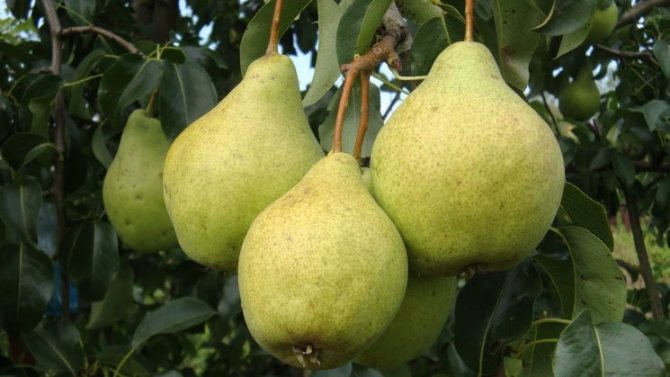

Veles
An autumn variety of pear, which reaches a height of no more than 3 m. It has a rather dense spreading crown of a pyramidal shape. The maximum weight of fruits reaches 180 g. Their skin is painted in a beautiful golden color and covered with a pinkish blush. Their flesh is very juicy, tender and oily, and the taste of the fruit is unusually sweet. The first harvest will have to wait at least 5 years, but Veles bears fruit steadily. Planting and leaving Veles pears are no different from other dwarf varieties.
The disadvantage is the average keeping quality of fruits (only about 2 months), but in general Veles has a lot of positive characteristics.
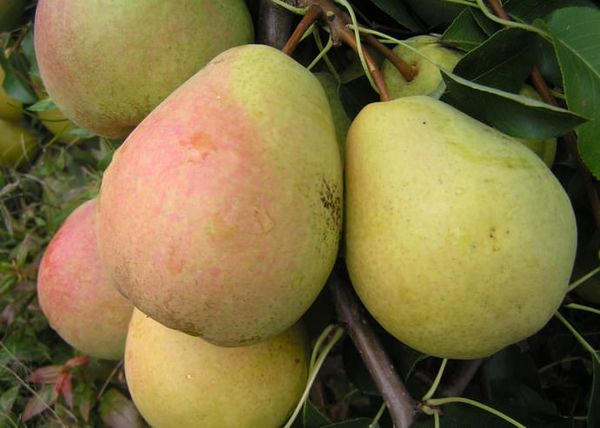

Garden formation
Usually fruit trees of different heights are grown in the garden. To form a garden, you need to plant dwarf pear trees on the southern and eastern sides. Place semi-dwarf seedlings behind them.Vigorous fruit trees are best planted in the northern part. If the garden has already been created, it is necessary to carefully examine which tall trees can be removed or rejuvenated. So, the garden will be brighter and more space will appear.
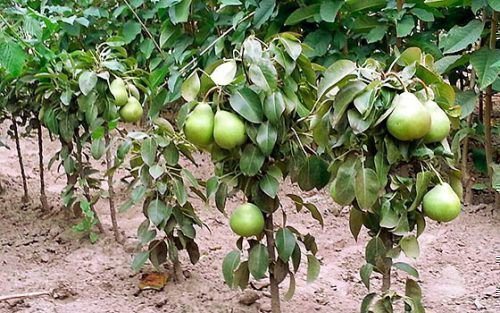

The first harvest of trees is given in the second year.
Dwarf pears are often planted in rows between tall trees. As long as the large trees grow, the dwarf trees can be harvested.
Small pears love a lot of sun. But sometimes the sun can be harmful. So in early spring, the bark of young trees can be damaged by sunburn. To prevent this, lime is applied to the bark in the spring. Bad for trees in hot weather, when the temperature exceeds 30 degrees. Then there may be burns on the fruits. You can see a good mix of dwarf and strong growing trees in the gardens of the Moscow region.
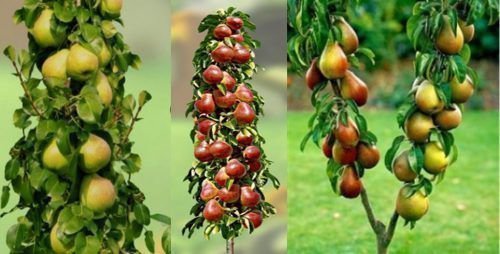

Columnar pears are a type of dwarf species
Honey
Popular mid-size. Used by designers to decorate the landscape. If conditions are right, one tree can produce up to 15 kg of fruit.
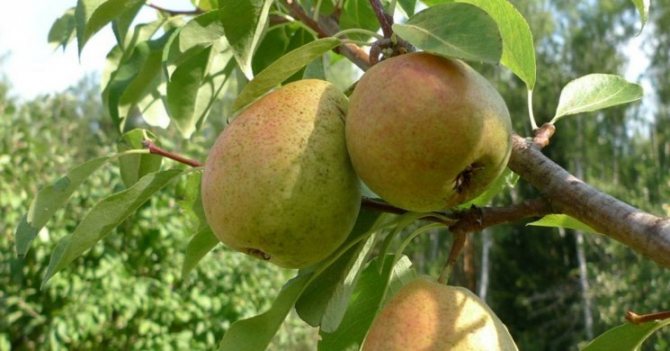

Fruiting occurs at the age of three. Fruits are slightly ribbed and irregular laterally convex. The weight of one fruit can fluctuate within 400 g. The color of the skin is yellow-green. The pulp is fleshy, with a strong aroma, sweet.
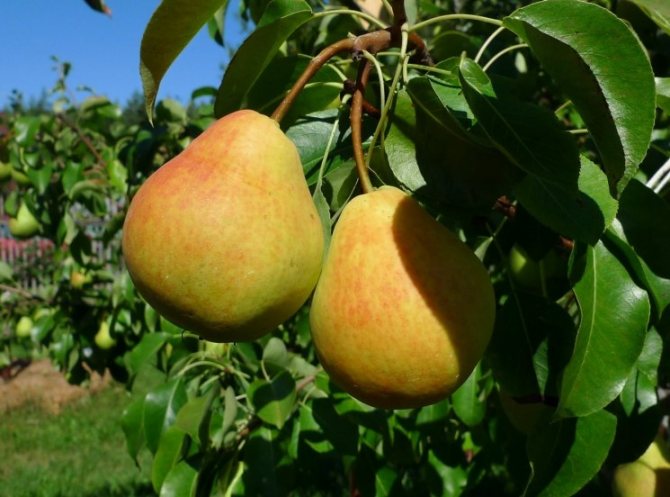

Trees tolerate winter well and are resistant to disease. Due to their simplicity, they are advised to novice gardeners.
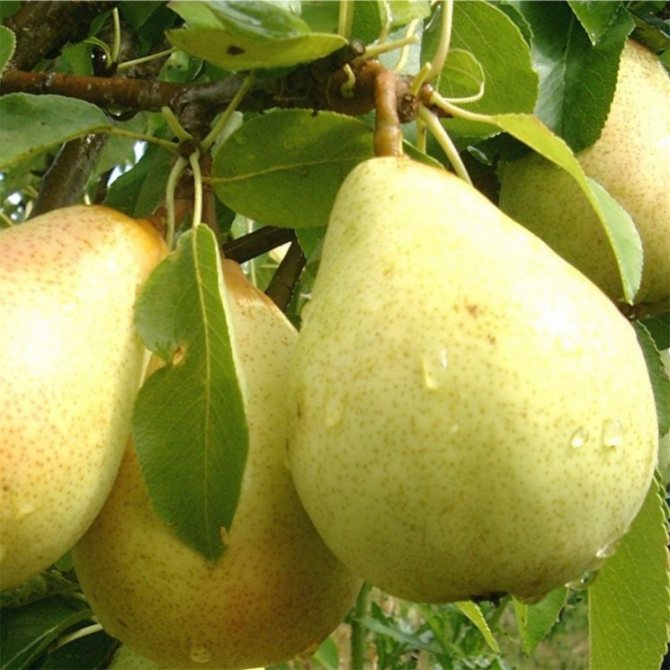

Among such a huge variety of varieties, even the most fastidious gardener will be able to choose the option most suitable for its characteristics. Before you go to the store, you just need to clarify the climatic conditions of your area and determine the optimal fruiting period for you.
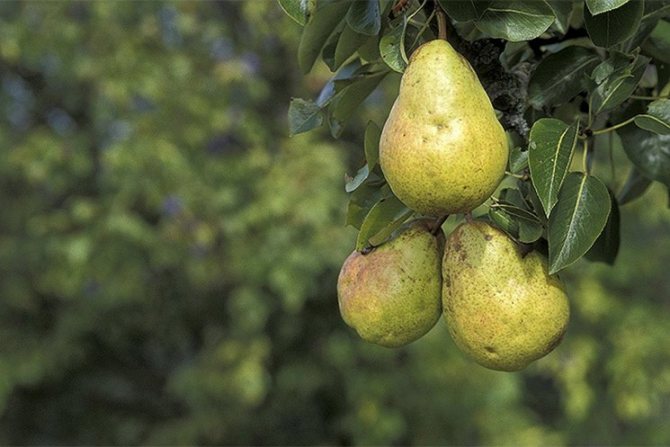

Kondratyevka
The fruits ripen by the beginning of autumn. This happens only in the 5th year after planting in the ground, but the yield is notable. The weight of one fruit is 230 g. The pulp is quite juicy, has the most delicate texture, sweet taste and spicy smell. The color of the peel is green, slightly yellowish.
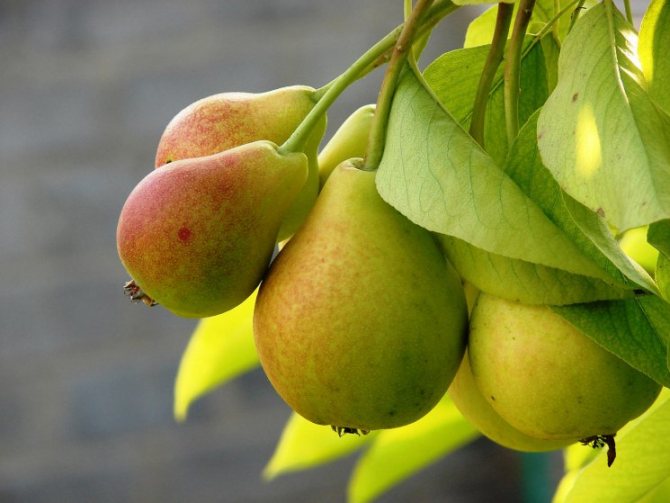

Height - 10-12 m. The shape of the trunk is pyramidal. The branches are slightly drooping. The peculiarity is slow growth. Basically, there is a build-up of green mass. Over time, this becomes an advantage - the yield increases.
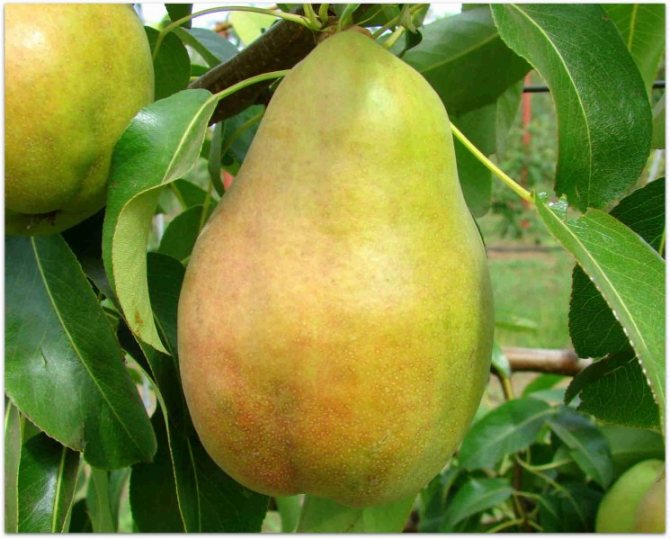

Pear for the Volga region and Central Russia
Scientists and practicing gardeners have identified a list of the best pear varieties for the Middle Lane. They are resistant to dryness in summer, severity of winter, rainy fall.
Lada
Summer hybrid variety for the Middle Lane. A pyramidal tree of medium height with bent branches, dark gray bark and glossy dark green foliage. Ripe pears of medium size (maximum 105 g), sweet with a delicate sourness. The skin is thin, yellow-greenish. The fruits on the branches are not overexposed, otherwise they become soft, acquire a rust-colored spot, and fall off. Lada ripens by July, annually delighting with the super harvest. It is resistant even to abnormal frosts, has received good resistance against pests, rarely gets sick.


Chizhovskaya
Self-pollinated winter variety for the Central strip, the Volga region and adjacent regions. A hybrid named after S. Chizhov (created together with S. Potapov). Pears are ripened by the second decade of August. Medium size, 155-160 g, sweet, aromatic, with yellow skin and delicate texture. They do not hold on to the branches for a long time, it is better to pluck them slightly greenish. One of the most winter-hardy varieties of pears, however, they gradually become smaller. You can counter this with annual pruning.


Allegro
The variety was obtained after artificial pollination of the Osennyaya Yakovleva pear. Resistant to abnormal cold weather, diseases, does not need careful adherence to agricultural techniques. Bears fruit constantly, from the third season. Long fruits grow larger from year to year. They grow one at a time. A tree of medium height, weight of pears from 125 g. Juicy, sweet, spicy-aromatic pulp is covered with a dense yellowish-red peel.The harvest ripens by the beginning of August, lasts until the crescent.


Bessemyanka
A well-deserved high-yielding variety for the Central regions and the Middle Belt. The seedlings are strong, they grow quickly, they give the harvest to adults without "respite", at the end of summer. Pears are small, ripe, soften, turn yellow. They grow one at a time. On a branch or plucked, they are stored on average 16-22 days.
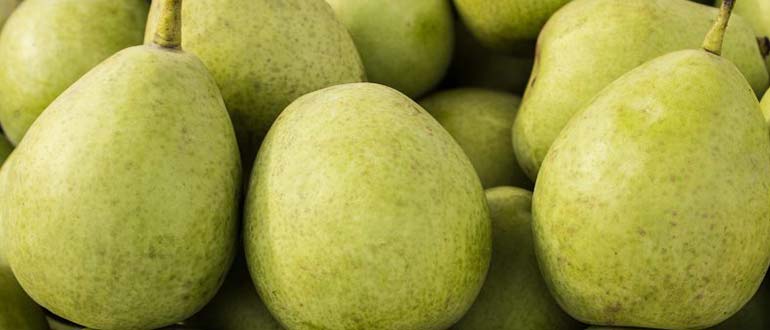

Skorospelka from Michurinsk
A winter-hardy hybrid, named after the very early ripening dates (July) and the author - the famous Soviet breeder I. V. Michurin. It is a tall, dense pyramidal tree. Fruits are smallish (up to 95 g), with a yellow skin. But the sweetness and juiciness are above average. It is better to pick when they are still hard, otherwise they will be stored for no more than a week. Resistant to diseases and pests.


Varieties of fruitful pears - champions
In addition to the long-term storage of amateur gardeners, agricultural entrepreneurs are interested in the seasonal productivity of fruit trees. High-yielding, capable of producing 50 kg from young animals and 100-250 kg and even 400 kg from ripe pears, include:
- "Curé" is strong-growing. Bears abundantly in the third year - up to 50 kg. From 25-year-old pears, you can harvest 300-400 kg of 250 grams of fruit. When ripe in storage, the light green color changes to yellow with dark blotches. By the second month, the sweetish-tart tanginess grows dull, the aroma dissipates. If you expose it from the cold to the warmth, it will deteriorate completely on the third day;
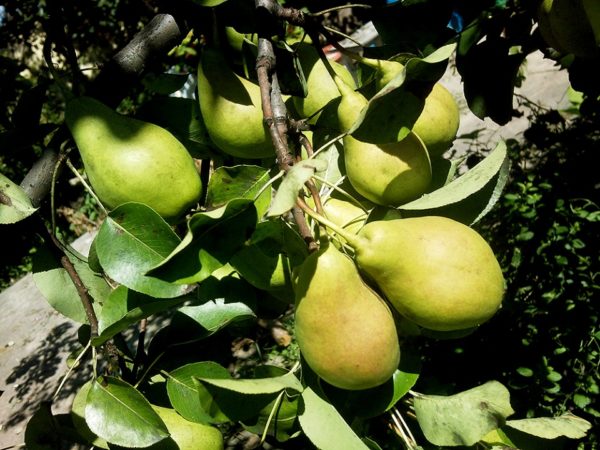

- "Saratovka" is a 200-gram golden delicacy for those with a sweet tooth that does not lose its flavor brightness for up to six months. The norm is a 100 kg yield. But there is also a minus: with its characteristic frost resistance, resistance to powdery mildew diseases, it is drought-vulnerable;
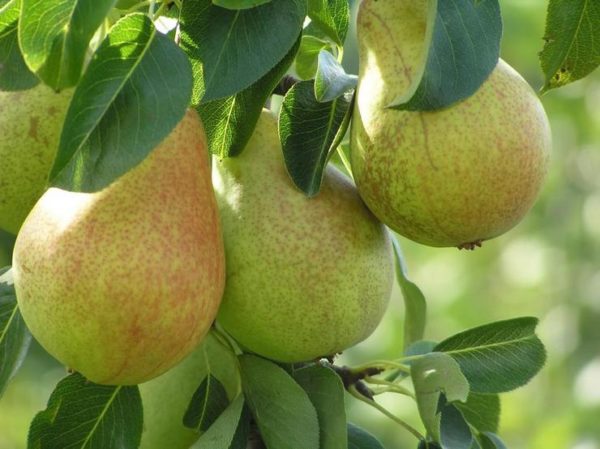

- "Lyra" - you need to eat it before December. Regular fruiting record - 70 kg. Stable-yielding. Expressively juicy, aromatic and rich, 200 g of continuous sweetness;
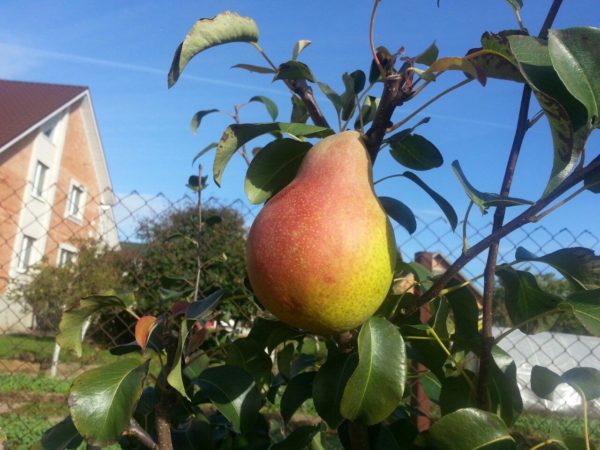

- Low-yielding in the seventh year of life - only up to 22 kg, and abundant after 15-20 years (up to 220 kg), ideal for the Moscow region "Lyubimitsa Yakovleva" with a quince flavor. Maybe even after the first November frosts, it can hang on the branches without compromising the taste and market quality. Transportable until spring. Requires the neighborhood of pollinators ("Summer Duchess" is the optimal helper). She prefers loam and black soil;


- "Bere winter Michurina" is self-fertile. Loves lighted, poorly ventilated places. Does not tolerate stagnant moisture at the roots. Does not lose its thick savory and tartness until January-February. Small - up to 140 g (ideal for canning). A quarter of a centner is the usual yield for a ten-year-old garden. Changes salad color when harvested to almost canary color with lateral blush during aging. Excellent raw material for compotes, candied fruits, drying and jam;
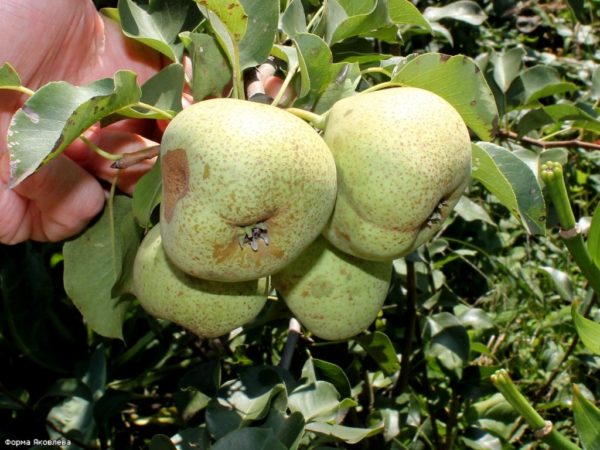

- "Miracle" - pyramidal, 5-meter high, with thin branches. The color is similar to the gooseberry, but without stripes, and with a speck, slightly elongated. 60-80 kg per season is not the limit. Until frost, you can not shoot without sacrificing quality.
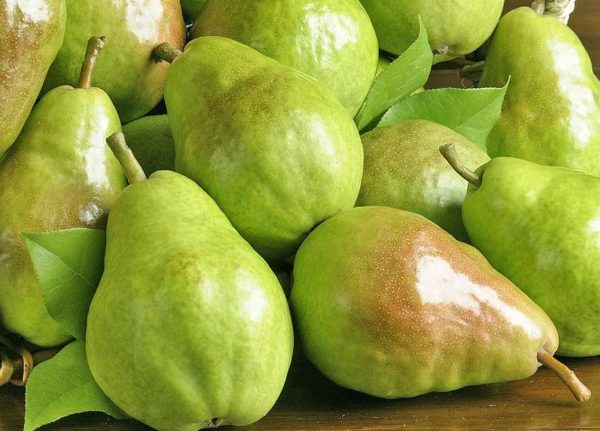

Long-lasting high-yielding leaders
The next parameter of importance in the description of winter-hardy late-ripening is the preservation of their presentation and taste. And there are some favorites here:
- "Belorusskaya Late" - early ripening, uniformly sized up to 120, wide pear-shaped, rough fruits - tasty and sweet until February. It is prone to shallowness (especially in a generously productive year) and rapid thickening of the crown. Requires frequent pruning. Not located on clay, sandy soils. Opponent of stagnant water. Ripens by the end of September. Delicious raw and baked, used for jam, mashed potatoes, jams and after 8 months;
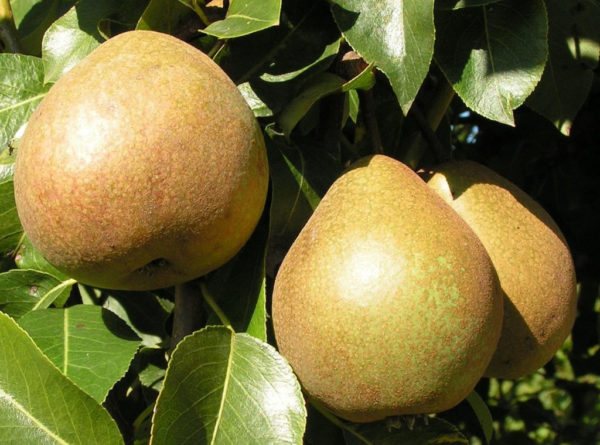

- "Pervomayskaya" - mixed fruiting. Compact. Medium-sized - from 140 to 220 g. Smooth skin with a waxy coating. Creamy pulp with slight granulation - resembles a peach. Suitable for the Central and Black Earth regions.Prefers low-alkaline soil, pruning and feeding twice a year. Only warm water irrigation. Root rot, fungal sores are not terrible for her, but bacteriosis requires prophylactic spraying with Bordeaux solution. September-October ripening. Does not deteriorate on average 230 days;
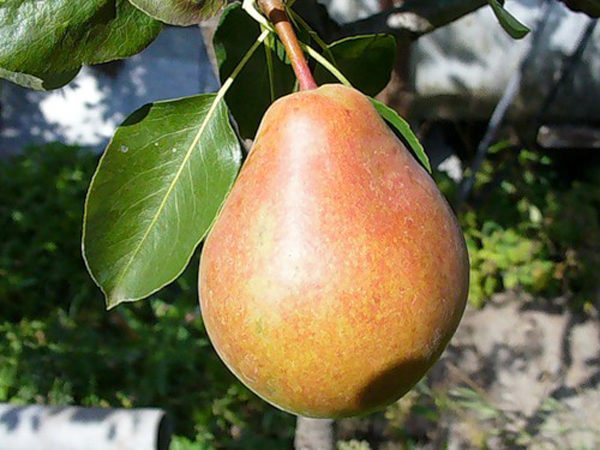

- "Winter kubarevidnaya" - drought-resistant. Withstands temperature drops that are critical for the middle band. It pleases with the harvest only for 6-7 years, but annually produces 70-100 kg of round, terracotta-sided fruits with a rough skin. 200 gram weight. When filled, it turns yellow and is taken with subcutaneous dots. Removable maturity - late September - early October, consumer - December. Good consumer qualities - and in March it is still strong-aromatic, juicy-rich.
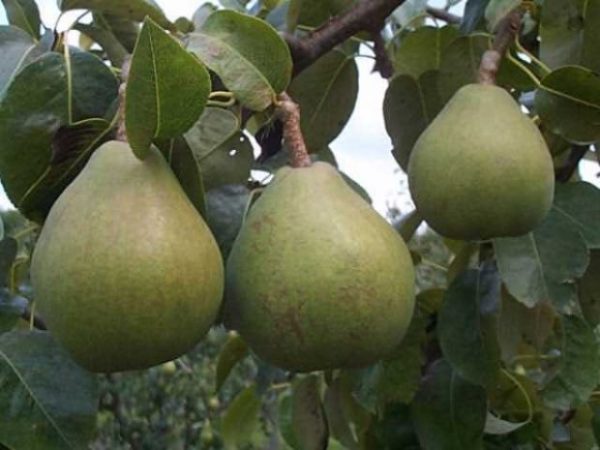

Proper storage - long tasting
Winter species are plucked not when they become soft, but also green-yellow, hard (the seed inside should be brownish). In September and early October. Packed up, placed in a dry, well-ventilated room (it is possible in a warmed, well-ventilated attic of a barn, courtyard kitchen) and do not touch for about a month. During this time, they reach, filling with juiciness, aroma and softness. Only after that they can be preserved, lowered into the basement / cellar, vegetable store.
Pears love to be picked gently: no bumps with skin damage or dents. It is better to collect them after the dew subsides (only dry!) - at the stage of technical maturity (when they lose their greenness and get under way with yellowness). Each fruit, along with the stalk (1), should be wrapped / wrapped in clerical, writing or brown kraft paper (newspaper is also acceptable), then laid out in two layers (the third row is acceptable, but not desirable) with cuttings upward in boxes, the bottom of which is fumigated for disinfection with smoke and covered with thick paper or straw. It can be plastic, but it is preferable, of course, a wooden container with gaps / slots between the planks.
The room for ripening should be dark, dry and well ventilated (a natural, but not damp draft is encouraged). The temperature in it should not fall below +8 ° C and rise above +20 ° C (standard - +14 ° C).
Three weeks or a month (rarely two) they are only checked, but not eaten. During this time, both taste and juiciness, coupled with aroma, come into force. If it becomes necessary to shorten the period of entry into full maturity, pears can be put in that paper bag, where there are still slightly greenish bananas or ripe apples. So, they can be eaten in a week.
Then they are lowered into the pantry (it is not necessary to free them from paper), the basement / cellar, laid on the balcony (if it is sheathed with insulation, and the temperature there in winter does not drop to zero and does not go into minus) and cover with a thick canvas cloth. It is desirable that the boxes are not adjacent to potatoes or cabbage and are raised above the ground by 20 centimeters or stand on shelves.
A few more ways (after they have reached the desired condition):
- Fill the container with dry river (sifted construction) sand or coniferous sawdust. Lay the fruits with their tails up, 2–3 cm apart from each other. Sprinkle each tier. Only cuttings should look out of the sand. The middle of winter will delight you with a pear scent and pure relish.
- Dig a one and a half meter hole into the depths. Lay a coniferous board, pallets or pine / spruce, juniper branches at the bottom. Place pears in paper bags (postal parcel paper) with small but fairly frequent holes. Cover with spruce branches, a board. Sprinkle with earth. From the pros - freshness lasts until spring. Of the minuses - the easy accessibility of the crop for rodents, although the needles protect, but not one hundred percent.
- Empty one of the shelves of the refrigerator and put plastic bags (with ventilation slots-vents) with pears packaged in 500-700 g on it.Extremely low temperature - 3-4 ° C. Apples, carrots, beets should be excluded as neighbors. Short-lived (maximum - two months), but convenient, especially if there is a large family and there is no cold pantry.
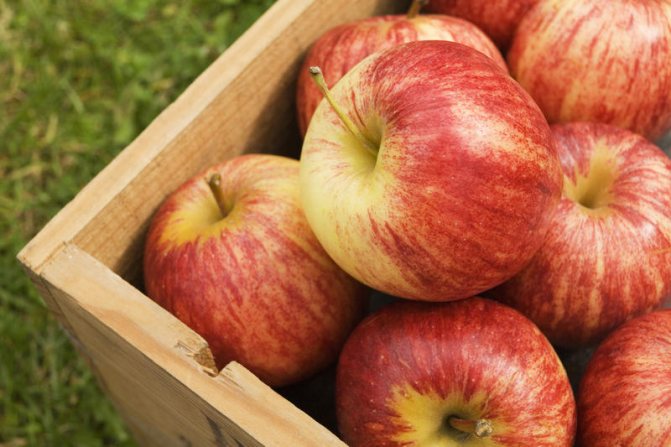

You may be interested in:
The best winter varieties of apples stored until spring Apple trees are the most common fruit trees in our country. Juicy, sweet or slightly sour fruits ... Read more ...
How to choose a seedling?
Professionals advise using two-year seedlings for planting. When selecting seedlings, special attention is paid to the condition of the tree itself; the young shoot should be elastic and not dry, with a smooth bark of the same color.
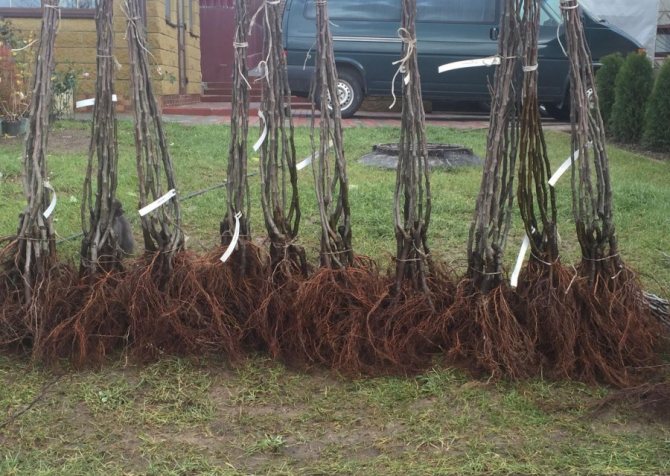

The height of the seedling is usually 70-80cm. Cut roots should be moist and light. In order not to be mistaken in the choice, we advise you to look at photos of pear seedlings that have successfully taken root.
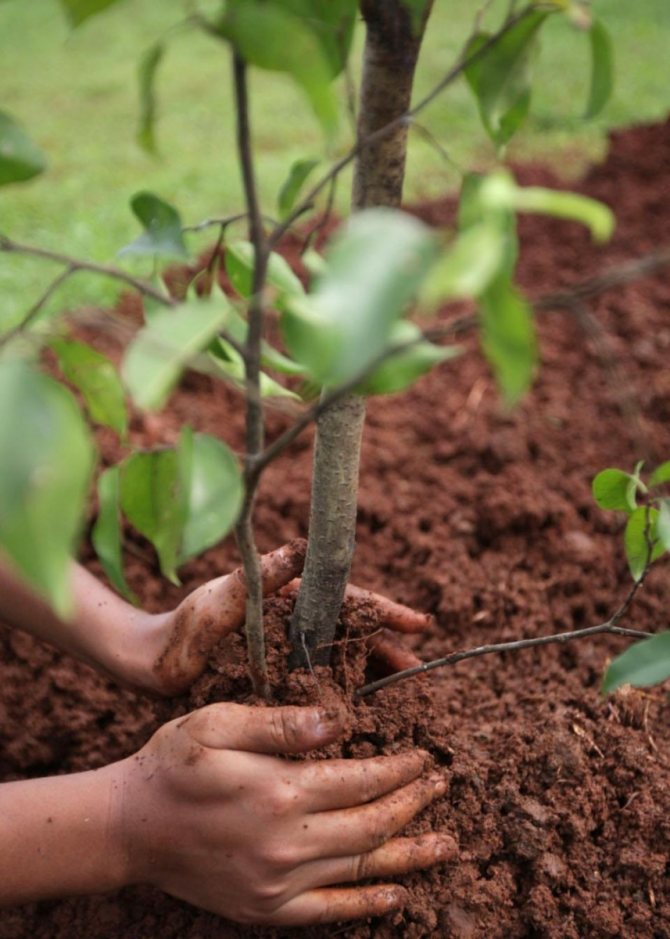

Preparation for planting should start by immersing the root system of the seedling in a container with a solution of root stimulant, for example, root. It should also be added to the water that will spill the landing recess. Long roots on the side and in the center are cut off ten centimeters before planting, and the leaves, if any, are cut off.
